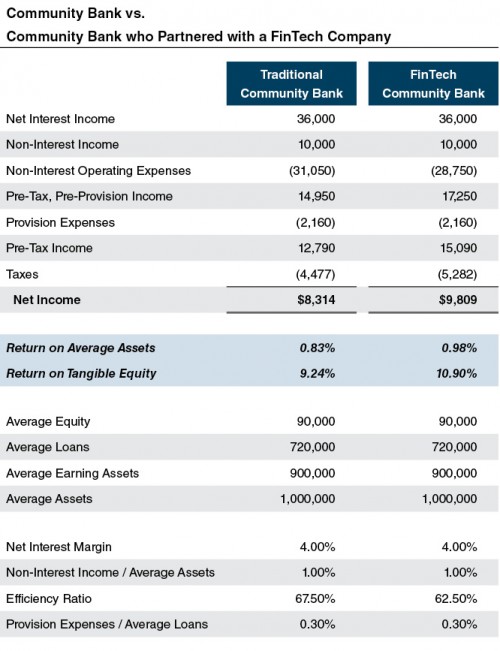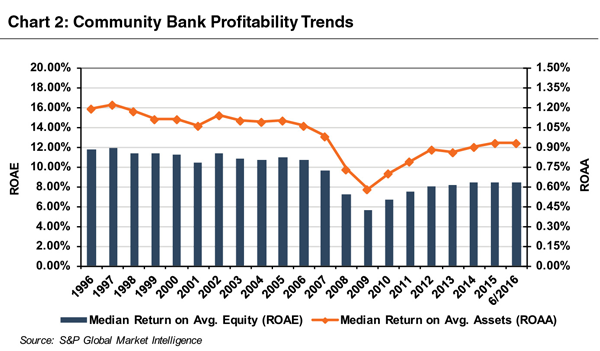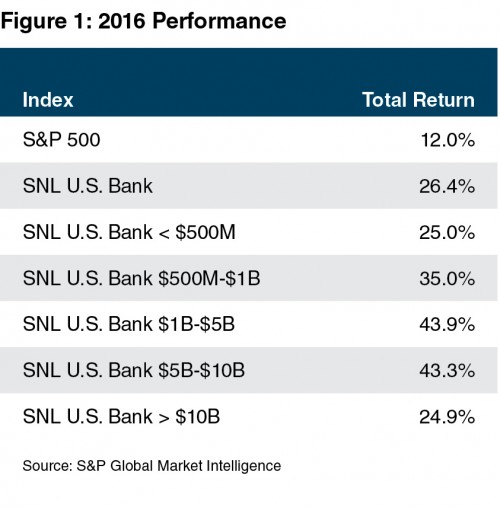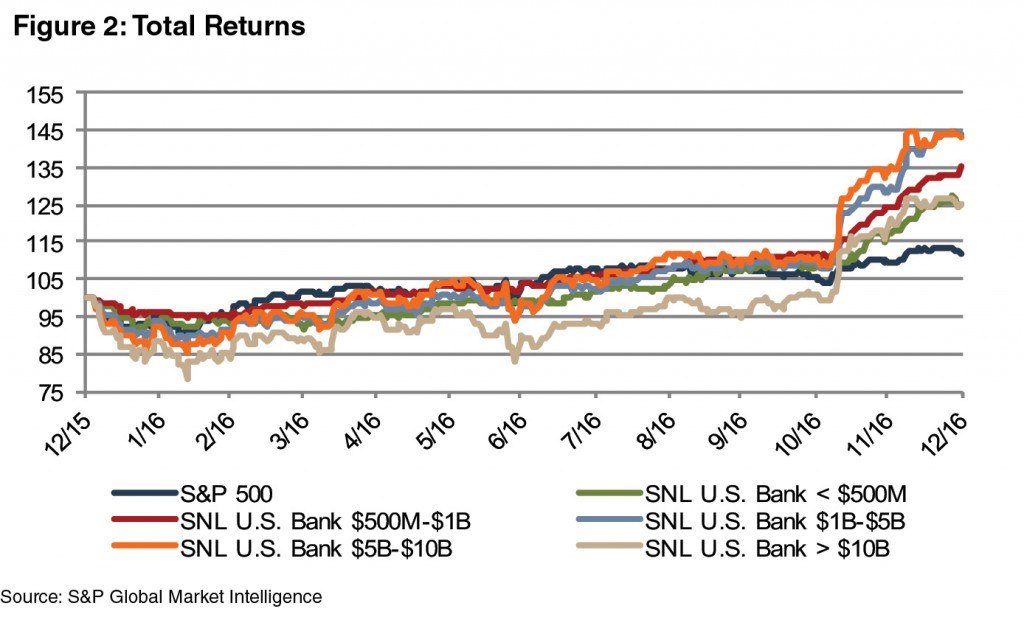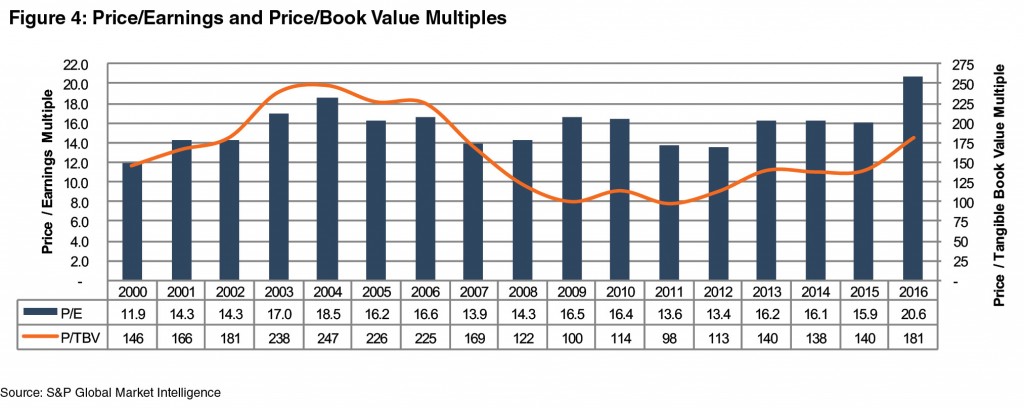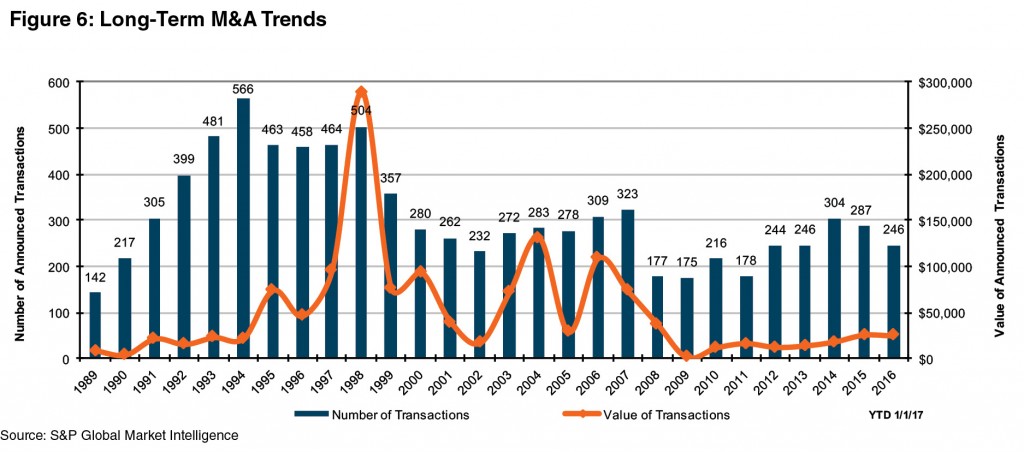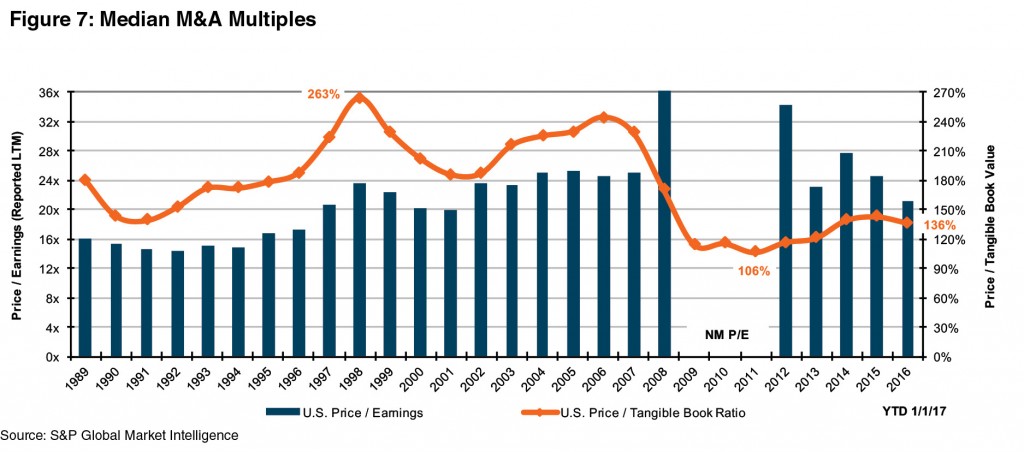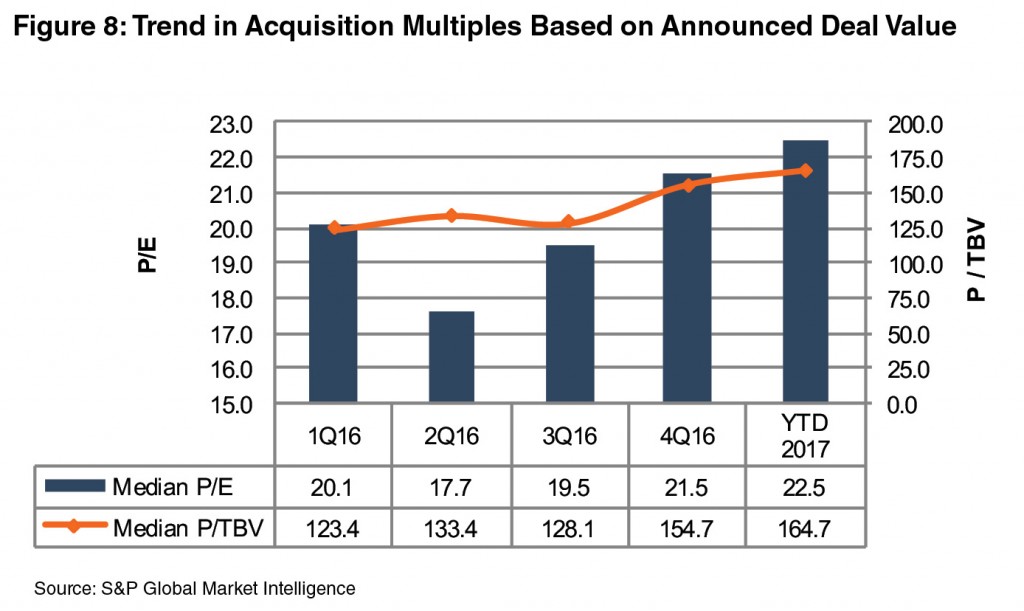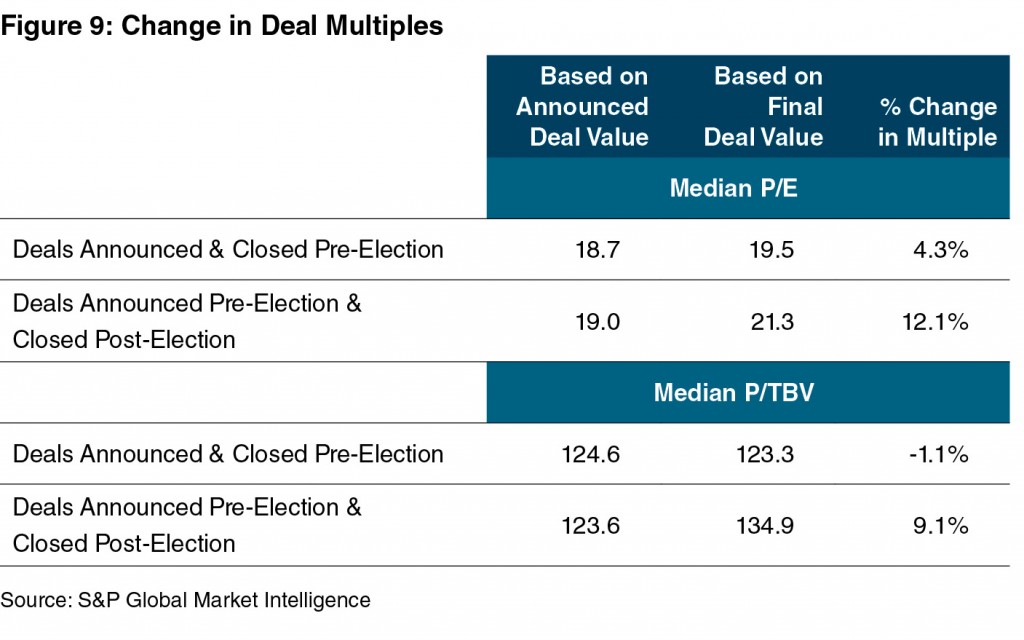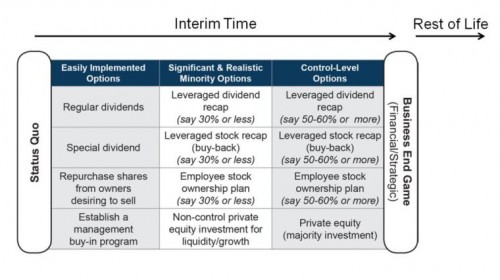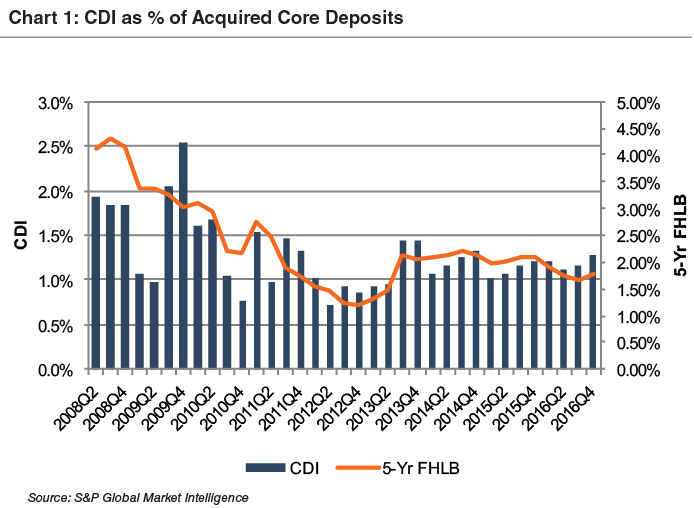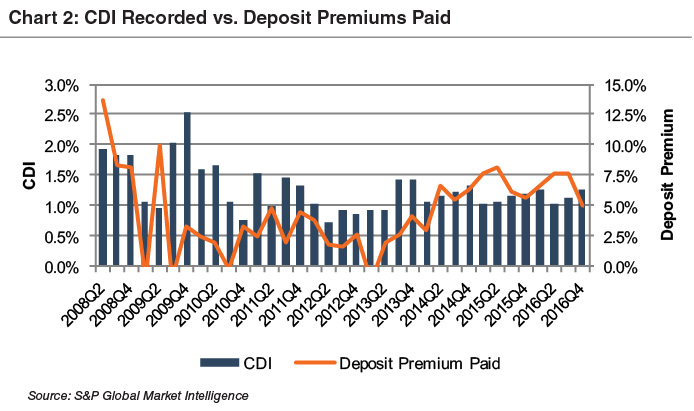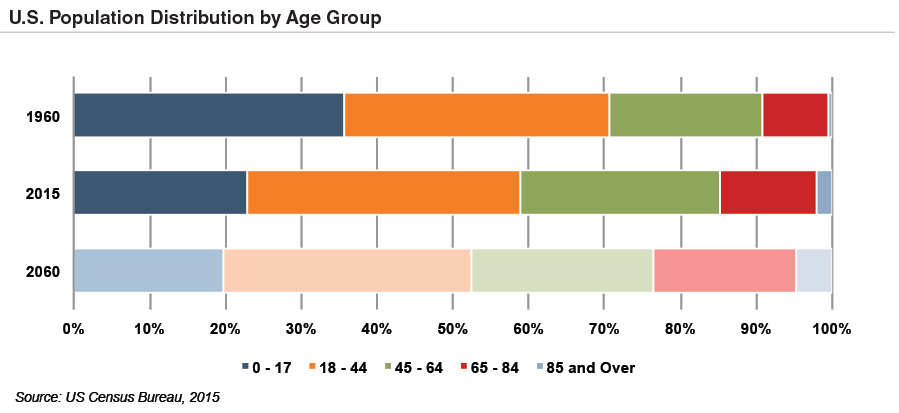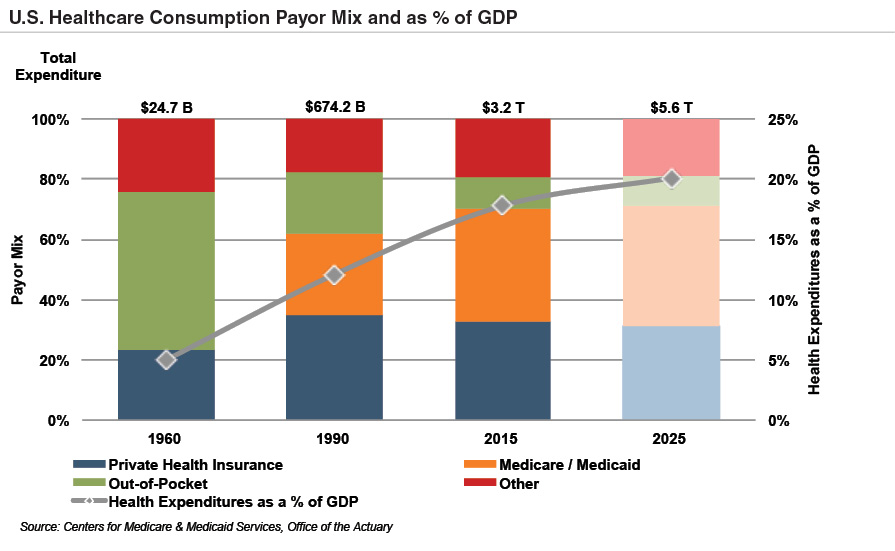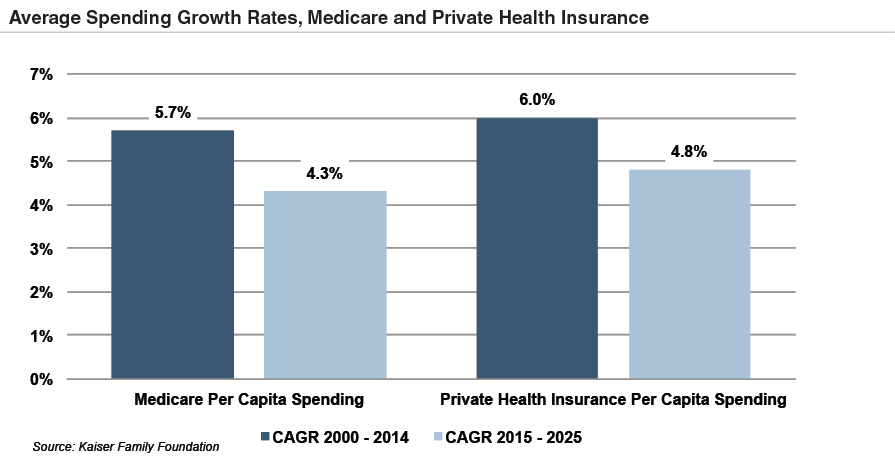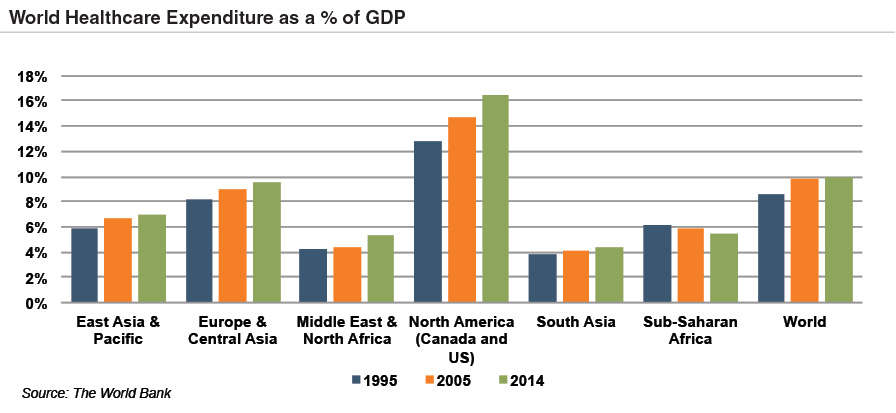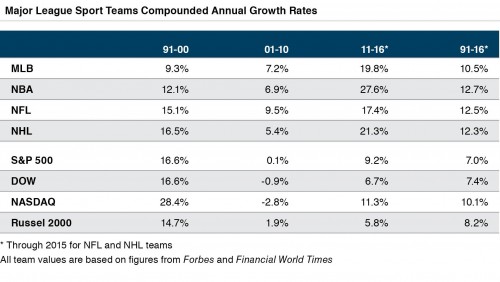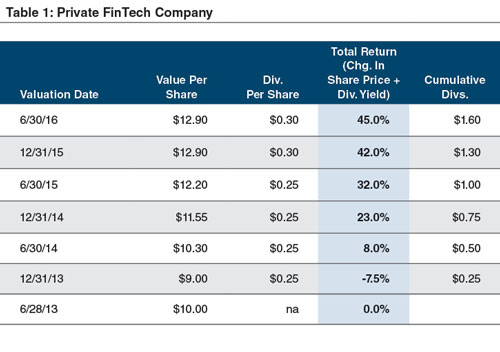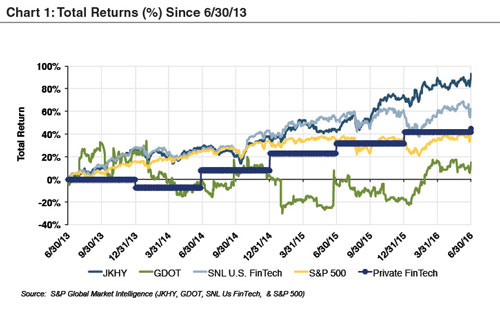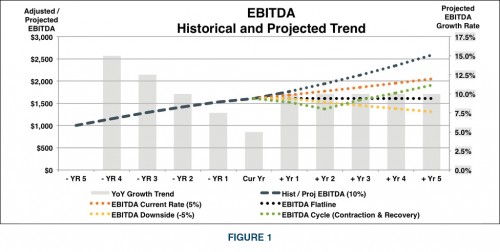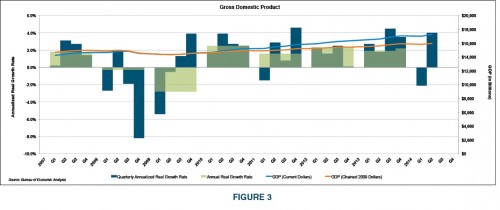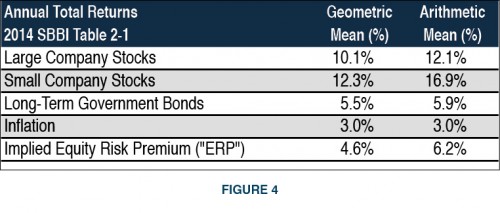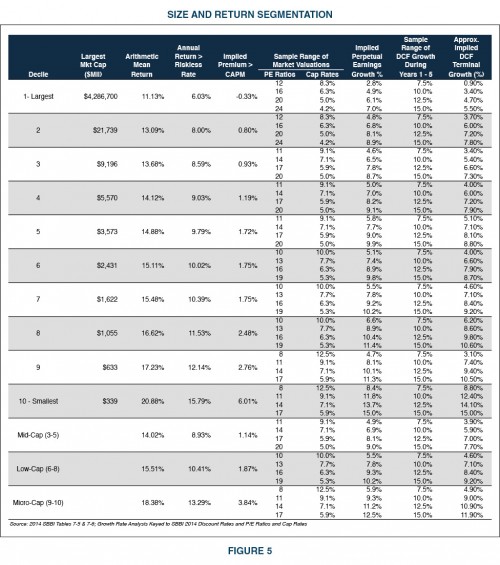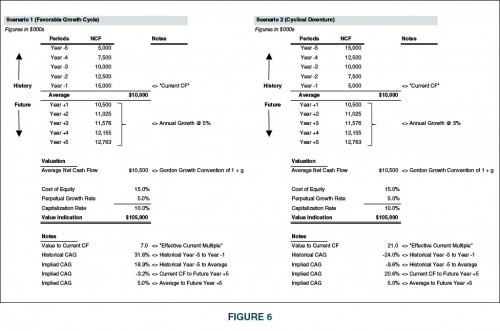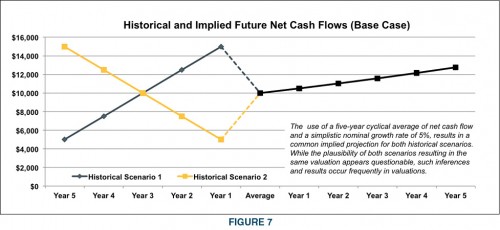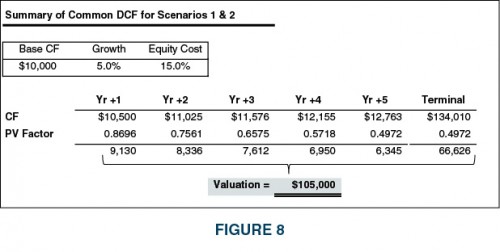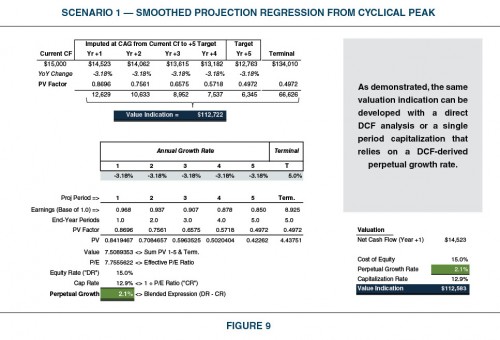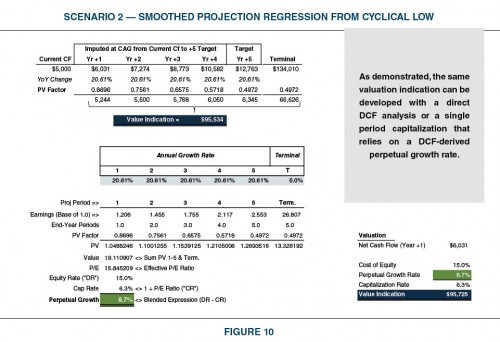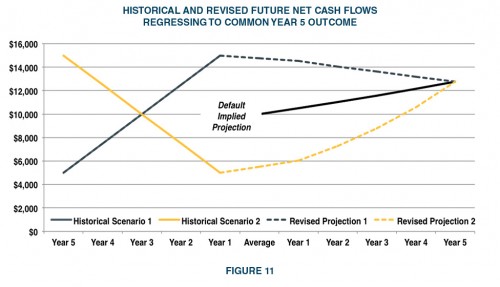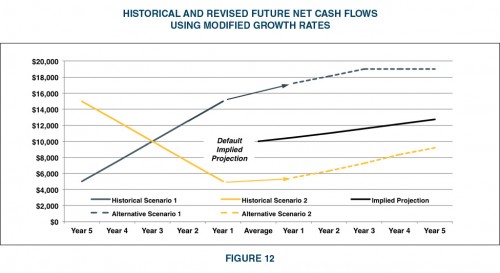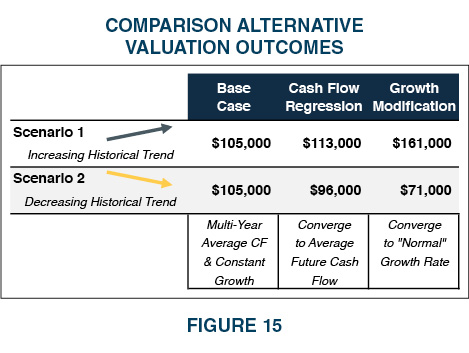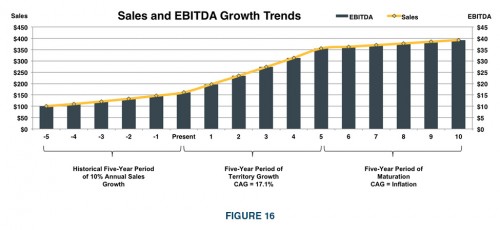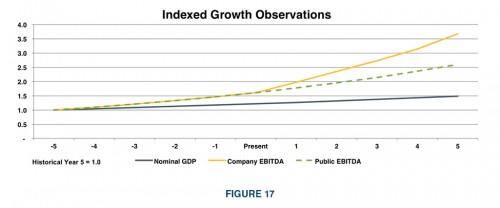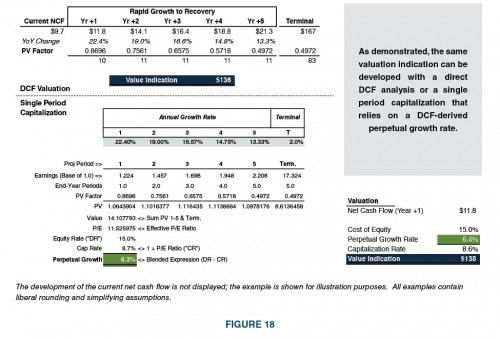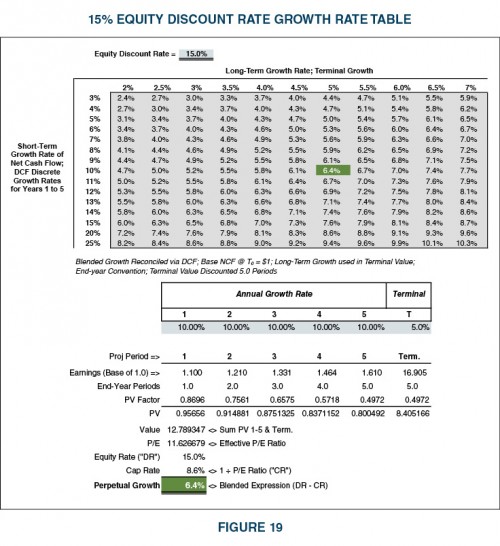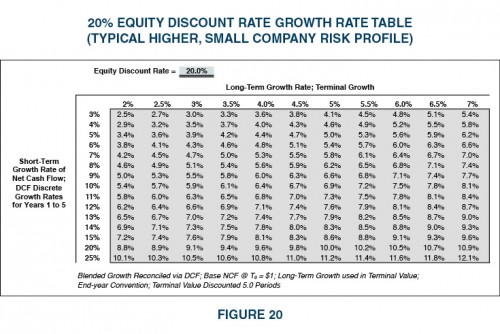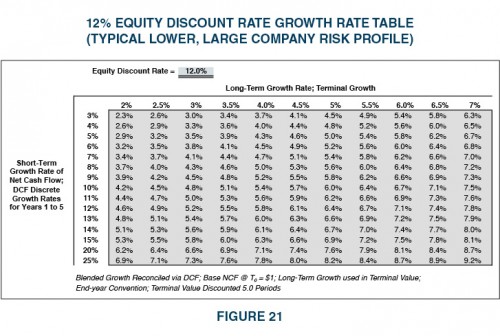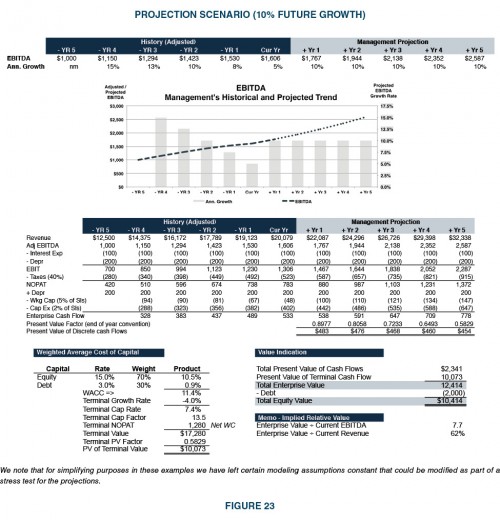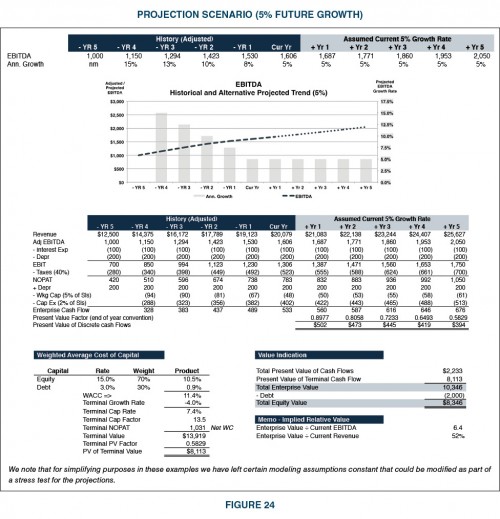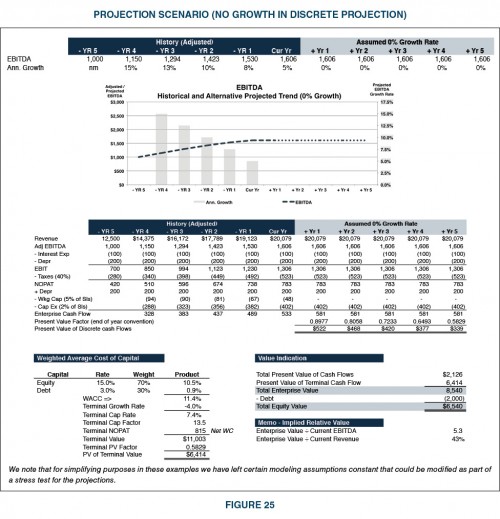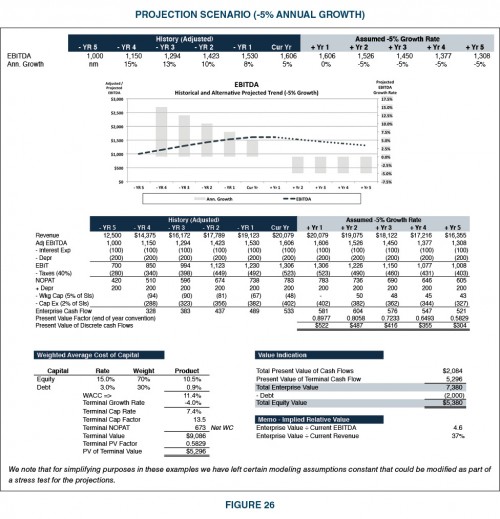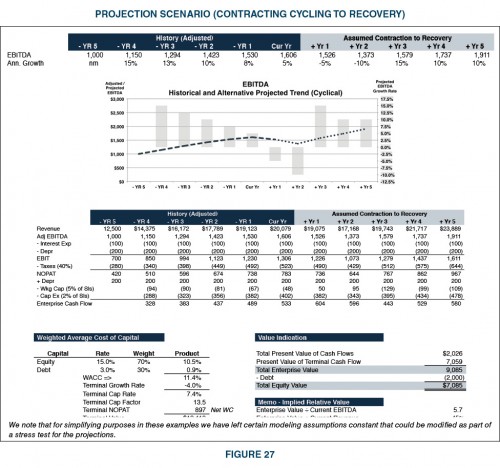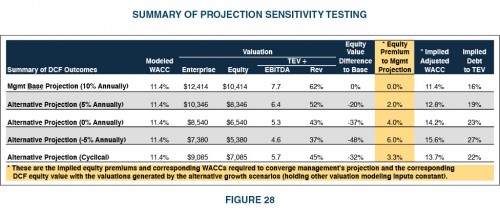Creating Value at Your Community Bank Through Developing a FinTech Framework
This discussion is adapted from Section III of the new book Creating Strategic Value Through Financial Technology by Jay D. Wilson, Jr., CFA, ASA, CBA.
I enjoyed some interesting discussions between bankers, FinTech executives, and consultants at the FinXTech event in NYC in late April. One dominant theme at the event was a growing desire of both banks and FinTech companies to find ways to work together. Whether through partnerships or potential investments and acquisitions, both banks and FinTech companies are coming to the conclusion that they need each other. Banks control the majority of customer relationships, have a stark funding advantage and know how to navigate the maze of regulations, while FinTechs represent a means to achieve low-cost scaling of new and traditional bank services. So one key question emerging from these discussions is: Who will survive and thrive in the digital age? As one recent Tearsheet article that I was quoted in asked: Should fintech startups buy banks? Or as another article discussed: Will banks be able to compete against an army of Fintech startups?
Build, Partner, or Acquire
Banks face a conundrum of whether they should build their own FinTech applications, partner, or acquire. FinTech companies face similar questions, though the questions are viewed through the prism of customer acquisition rather than applications. Non-control investments of FinTech companies by banks represent a hybrid strategy. Regulatory hurdles limit the ability of FinTech companies to make anything more than a modest investment in banks absent bypassing voting common stock for non-voting common and/or convertible preferred.
While these strategic decisions will vary from company to company, the stakes are incredibly high for all. We can help both sides navigate the decision process.
As I noted in my recently published book, community banks collectively remain the largest lenders to both small business and agricultural businesses, and individually, they are often the lifeblood for economic development within their local communities. Yet the number of community banks declines each year through M&A, while some risk loosened deposit relationships as children who no longer reside in a community where the bank is located inherit the financial assets of deceased parents. FinTech can loosen those bonds further, or it can be used to strengthen relationships while providing a means to deliver services at a lower cost.
Where to Start
In my view, it is increasingly important for bankers to develop a FinTech framework and be able to adequately assess potential returns from FinTech partnerships. Similar to other business endeavors, the difference between success and failure in the FinTech realm is often not found in the ideas themselves, but rather, in the execution.
Banks face a conundrum of whether they should build their own FinTech applications, partner, or acquire.
While a bank’s FinTech framework may evolve over time, it will be important to provide a strategic roadmap for the bank to optimize chances of success. Within this framework, there are a number of important steps:
- Determining which FinTech niche to pursue;
- Identifying potential FinTech companies/partners;
- Developing a business case for those potential partners and their solutions; and
- Executing the chosen strategy.
For a number of banks, the use of FinTech and other enhanced digital offerings represents a potential investment that uses capital but may be deemed to have more attractive returns than other traditional bank growth strategies. Community banks typically underperform their larger brethren (as measured by ROE and ROA) because fee income is lower and expenses are higher as measured by efficiency ratios. Both areas can be enhanced through deployment of a number of FinTech offerings/solutions.
The Importance of a Detailed IRR Analysis
The decision process for whether to build, partner, or acquire requires the bank to establish a rate of return threshold, which arguably may be higher than the institution’s base cost of capital given the risk that can be associated with FinTech investments. The range of returns for each strategy (build, partner, or acquire) for a targeted niche (such as payments or wealth management) provides a framework to help answer the question how to proceed just as is the case with the question of how to deploy capital for organic growth, acquisitions, and shareholder distributions. The same applies for FinTech companies, though often the decision is in the context of whether to accept dilutive equity capital.
A detailed analysis, including an IRR analysis, helps a bank determine the financial impact of each strategic decision and informs the optimal course.
While each option presents a unique set of considerations and execution issues/risks, a detailed analysis, including an IRR analysis, helps a bank determine the financial impact of each strategic decision and informs the optimal course. A detailed analysis also allows the bank to compare its FinTech strategy to the bank’s more traditional growth strategies, strategic plan, and cost of capital. See the table to the right for an example of a traditional community bank compared to a bank who has partnered with a FinTech company.
Questions Regarding Partnering
Beyond the strategic decisions and return analyses, some additional questions remain for community banks that consider FinTech partners, including:
- Is the bank comfortable with the FinTech company’s risk profile?
- What will the regulatory reaction be?
- Who will maintain the primary relationship with the customer?
- Is the FinTech partnership consistent with the bank’s long-term strategic plan (a key topic noted in the OCC’s whitepaper on supporting innovation)?
Questions Regarding Acquiring
Should the community bank ultimately decide to invest in a FinTech partner a number of other key questions emerge, such as:
- What is the valuation of the FinTech company?
- How should the investment be structured?
- What preferences or terms should be included in the shares purchased from the FinTech company?
- Should the bank obtain board seats or some control over the direction of the FinTech Company’s operations?
How Mercer Capital Can Help
To help both banks and FinTech companies execute their optimal strategies and create maximum value for their shareholders, we have a number of solutions here at Mercer Capital. We have a book that provides greater detail on the history and outlook for the FinTech industry, as well as containing targeted information to help bankers answer some of the key questions discussed here.
Mercer Capital has a long history of working with banks. We are aware of the challenges facing community banks. With ROEs for the majority below 10% and their cost of capital, it has become increasingly difficult for many banks to deliver adequate returns to shareholders even though credit costs today, are low. Being both a great company that delivers benefits to your local community, as well as one that delivers strong returns to shareholders is a difficult challenge. Confronting the challenge requires a solid mix of the right strategy as well as the right team to execute that strategy.
No one understands community banks and FinTech as well as Mercer Capital.
Mercer Capital can help your bank craft a comprehensive value creation strategy that properly aligns your business, financial, and investor strategy. Given the growing importance of FinTech solutions to the banking sector, a sound value creation strategy needs to incorporate FinTech into it and Mercer Capital can help.
- We provide board/management retreats to educate you about the opportunities and challenges of FinTech for your institution.
- We can identify which FinTech niches may be most appropriate for your bank given your existing market opportunities.
- We can identify which FinTech companies may offer the greatest potential as partners for your bank.
- We can provide assistance with valuations should your bank elect to consider investments or acquisitions of FinTech companies.
No one understands community banks and FinTech as well as Mercer Capital. We are happy to help. Contact me to discuss your needs.
This article first appeared in Mercer Capital’s Bank Watch, June 2017.
Infographic: 5 Reasons to Conduct a Shareholder Survey
Of all the well-worn clichés that should be retired, “maximizing shareholder value” is surely toward the top of the list. Since private companies don’t have constant public market feedback, attempts to “maximize” shareholder “value” are destined to end in frustration. While private company managers are not able to gauge instantaneous market reaction to their performance, they do know who their shareholders are. Wouldn’t it be better to make corporate decisions based on the characteristics and preferences of actual flesh-and-blood shareholders than the assumed preferences of generic shareholders that exist only in textbooks? If so, there is no substitute for simply asking. Here’s a quick list of five good reasons for conducting a survey of your shareholders.
For more information about conducting a shareholder survey, check out the article “5 Reasons to Conduct a Shareholder Survey.”
To discuss how a shareholder survey or ongoing investor relations program might benefit your company, learn more about our Corporate Finance Consulting or give us a call.
Corporate Finance Basics for Directors and Shareholders
To craft an effective corporate strategy, management and directors must answer the three fundamental questions of corporate finance.
- The Capital Structure question: What is the most efficient mix of capital?
- The Capital Budgeting question: Which projects merit investment?
- The Dividend Policy question: What mix of returns do shareholders desire?
These questions should not be viewed as the special preserve of the finance team. To maintain a healthy governance culture, all directors and shareholders need to have a voice in how these long-term decisions are made. This presentation is an example of the topics that we cover in education sessions with directors and shareholders. The purpose of the presentation is to provide directors and shareholders with a conceptual framework and vocabulary to help contribute to answering the three fundamental questions.
5 Reasons to Conduct a Shareholder Survey
Of all the well-worn clichés that should be retired, “maximizing shareholder value” is surely toward the top of the list. Since private companies don’t have constant public market feedback, attempts to “maximize” shareholder “value” are destined to end in frustration. While private company managers are not able to gauge instantaneous market reaction to their performance, they do know who their shareholders are. Wouldn’t it be better to make corporate decisions based on the characteristics and preferences of actual flesh-and-blood shareholders than the assumed preferences of generic shareholders that exist only in textbooks? If so, there is no substitute for simply asking. Here’s a quick list of five good reasons for conducting a survey of your shareholders.
- A survey will help you learn about your shareholders. A well-crafted shareholder survey will go beyond mere demographic data (age and family relationships) to uncover what deeper characteristics owners share and what characteristics distinguish owners from one another. We recently completed a survey for a multi-generation family company, and not surprisingly, one of the findings was that the shareholder base included a number of distinct “clienteles” or groups of shareholders with common needs and risk preferences. What was surprising was that the clienteles were not defined by age or family tree branch, but rather by the degree to which (a) the shareholder’s household income was concentrated in distributions from company stock, and (b) the shareholder’s personal wealth was concentrated in company stock. The boundary lines for the resulting clienteles did not fall where management naturally assumed.
- A survey will help you gauge shareholder preferences. The results from a shareholder survey will help directors and managers move away from abstract objectives (like “maximizing shareholder value”) toward concrete objectives that actually take into account shareholder preferences. For example, what are shareholder preferences for near-term liquidity, current distributions, and capital appreciation? Identifying these preferences will enable directors and shareholders to craft a coherent strategy that addresses actual shareholder needs. Conducting a survey does not mean that the board is off-loading its fiduciary responsibility to make these decisions to the shareholders: a survey is not a vote. Rather, it is a systematic means for the board to solicit shareholder preferences as an essential component of deliberating over these decisions.
- A survey will help educate the shareholders about the strategic decisions facing the company. While a survey provides information about the shareholders to the company, it also inevitably provides information about the company to shareholders. In our experience, the survey is most effective if preceded by a brief education session that reviews the types of questions that will be asked in the survey. Shareholders do not need finance degrees to be able to understand the three basic decisions that every company faces: (1) how should we finance operations and growth investments (capital structure), (2) what investments should we be making (capital budgeting), and (3) what form should shareholder returns take (distribution policy). Educated shareholders can provide valuable input to directors and managers, and will prove to be more engaged in management’s long-term strategy.
- A survey will help establish a roadmap for communicating operating results to shareholders. Public companies are required by law to communicate operating results to the markets on a timely basis, and many public companies invest significant resources in the investor relations function because they recognize that it is critical that the markets understand not just the bare “what happened” of financial reporting, but the “why” of strategy. Oddly, for most private companies, there is no roadmap for communicating results, and investor relations is either ignored or consists of reluctantly answering potentially-loaded questions from disgruntled owners (who may, frankly, enjoy being a nuisance). A shareholder survey can be a great jumping-off point for a more structured process for proactively communicating operating results to shareholders. An informed shareholder base that understands not only “what happened” but also “why” is more likely to take the long-view in evaluating performance.
- A survey gives a voice to the “un-squeaky” wheels. A shareholder’s input should not be proportionate to the volume with which the input is given. While the squeaky wheel often gets the grease, it is prudent for directors and managers to solicit the feedback regarding the needs and preferences of quieter shareholders. Asking for input from all shareholders through a systematic survey process helps ensure that the directors and managers are receiving a balanced picture of the shareholder base. A confidential survey administered by an independent third party can increase the likelihood of receiving frank (and therefore valuable) responses.
An engaged and informed shareholder base is essential for the long-term health and success of any private company, and a periodic shareholder survey is a great tool for achieving that result. To discuss how a shareholder survey or ongoing investor relations program might benefit your company, give one of our senior professionals a call.
Is FinTech a Threat or an Opportunity?
Adapted from the new book Creating Strategic Value Through Financial Technology by Jay D. Wilson, Jr., CFA, ASA, CBA.
In order to understand how FinTech can help community banks create strategic value, let us take a closer look at the issues facing community banks and discuss how FinTech can help improve performance and valuation. This is significant, particularly in the U.S., as community banks compose an important part of the economy, constitute the majority of banks in the U.S. and are collectively the largest providers of certain loan types such as agricultural and small business lending.
Threats to Community Banks
There are nearly 6,000 community banks with 51,000 locations in the U.S. (includes commercial banks, thrifts, and savings institutions). While community banks constitute the vast majority of banks (approximately 90% of U.S. banks have assets below $1 billion), the majority of banking industry assets are controlled by a small number of extremely large banks. These larger banks have acquired assets more quickly than community banks in the last few decades (as shown in Chart 1).
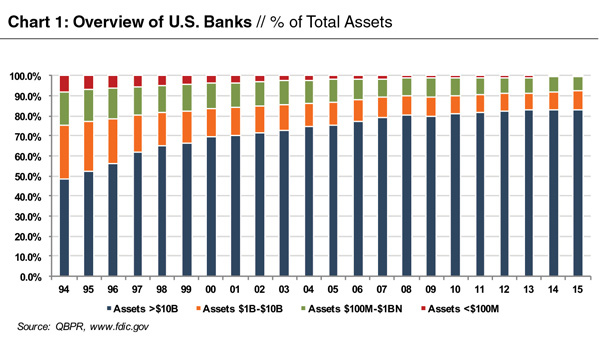
In addition to competition from larger banks and industry headwinds, community bankers are also attempting to assess and respond to the growing threat from the vast array of FinTech companies and startups taking aim at the banking sector. For perspective, a group of community bankers meeting with the FDIC in mid-2016 noted that FinTech poses the largest threat to community banks. One executive indicated that the payment systems “are the scariest” as consumers are already starting to use FinTech applications like Venmo and PayPal to send peer-to-peer payments. Another banker went on to note, “What’s particularly concerning about [the rise of FinTech] for us is the pace of change and the fact that it’s coming so quickly.”
These significant competitive pressures combined with other industry headwinds such as higher regulatory and compliance costs and a historically low interest rate environment have hurt returns on equity (ROEs) for community banks (Chart 2).
Opportunities for Community Banks
While many bankers view FinTech as a significant threat, FinTech also has the potential to assist the community banking sector. FinTech offers the potential to improve the health of community banks by enhancing performance and improving profitability and ROEs back to historical levels.
One way to better understand how FinTech can assist community banks is to understand where the Big Banks are outperforming smaller banks. Big Banks (defined as those with assets greater than $5 billion) have outperformed community banks consistently for many years. In the 20-year period from 1996 to 2016, Big Banks reported a higher return on asset (ROA) than community banks in each period except for 2009 (the depths of the financial crisis). Interestingly though, the source of outperformance is not due to net interest margin, perhaps the most common performance metric that bankers often focus on. Community banks had consistently higher net interest margins than Big Banks in each year over that 20-year period (1996-2016). Rather, the outperformance of the Big Banks can be attributed to their generation of greater non-spread revenues (i.e., non-interest income) and lower non-interest expense (i.e., lower efficiency ratios).
FinTech and Non-Interest Income and Efficiency Ratios
While FinTech can benefit community banks in a number of areas, FinTech offers some specific solutions where community banks have historically underperformed: non-interest income and efficiency. To enhance non-interest income, community banks may consider a number of FinTech innovations in niches like payments, insurance, and wealth management. Since many community banks have minimal personnel and legacy systems in these areas, they may be more apt to try a new FinTech platform in these niches. For example, a partnership with a robo-advisor might be viewed more favorably by a community bank as it represents a new source of potential revenue, another service to offer their customers and it will not cannibalize their existing trust or wealth management staff since they have minimal existing wealth management personnel.
FinTech can also enhance efficiency ratios and reduce expenses for community banks. Branch networks are the largest cost of community banks and serving customers through digital banking costs significantly less than traditional in-branch services and interactions with customers. For example, branch networks make up approximately 47% of banks’ operating costs and 54% of that branch expenditure goes to staffing. Conversely, the cost of ATM and online-based transactions are less than 10% of the cost of paper-based branch transactions in which tellers are involved. In addition to the benefits from customers shifting to digital transactions, community banks can utilize FinTech to assist with lowering regulatory/compliance costs by leveraging “reg-tech” solutions.
To illustrate the potential financial impact of transitioning customers to digital transactions for community banks, let’s assume that a mobile transaction saves the bank approximately $3.85 per branch transaction. If we assume that FinTech Community Bank has 20,000 deposit accounts and each account shifts two transactions per month to mobile from in-person branch visits, the bank would save approximately $150 thousand per month and approximately $1.8 million annually. These enhanced earnings would serve to enhance efficiency and improve shareholder returns and the bank’s valuation.
Moving beyond non-interest income and efficiency ratios, FinTech also offers a number of other potential benefits for community banks. FinTech can be used to help community banks compete against Big Banks more effectively by minimizing the impact of scale as more customers carry their branch in their pocket. By leveraging FinTech solutions, smaller banks can more easily compete against a large bank’s footprint digitally via the web or a mobile device. FinTech also offers many community banks an opportunity to enhance loan portfolio diversification and regain some market share after years of losing ground in certain segments (such as consumer, mortgage, auto, and student).
FinTech can also provide an additional touch point to improve customer retention and preference. While data is limited, some studies have shown that customer loyalty (i.e., retention) is higher for those customers that use mobile offerings and digital banking (online and mobile) is increasingly preferred by customers. While digital is clearly growing among customer preference, data has also shown that digital-only customers can be less engaged, loyal, and profitable than those who interact with the bank through a combination of interactions across multiple channels (digital, branches, etc.). So community banks that rely more heavily on their branch networks should find it beneficial to add digital services to complement their traditional offerings in order to enhance customer retention and preference.
Change Is Inevitable, Growth Is Optional
As technological advances continue to penetrate the banking industry, community banks will need to leverage technology in order to more effectively market to and serve small businesses and consumers in an evolving environment. Community banks will likely increasingly rely on a model that makes widespread use of ATM’s, the Internet, mobile apps and algorithm driven decision making, enabling them to deliver their services to customers in a streamlined and efficient manner.
Conclusion
Our world is changing quickly. FinTech can represent an opportunity for community banks. Understanding how FinTech will impact your institution and your response is critical today. Many community banks are actively surveying the FinTech landscape and pursuing a strategy to improve their digital footprint and services through partnerships with FinTech companies. Our new book, Creating Strategic Value Through Financial Technology, can help those banks considering their FinTech strategy as it provides information on the FinTech landscape and provides an overview of a few prominent FinTech niches (payments, wealthtech, insurtech, and banktech), case studies of successful (and unsuccessful FinTech companies), as well as an overview of some key ways to value FinTech companies and assess value creation when structuring FinTech acquisitions, investments, and/or partnerships.
Whatever your strategy, understanding how FinTech fits in and adapting to the current environment is incumbent upon any institution that seeks to compete effectively and Mercer Capital will be glad to assist. We have successfully worked with both traditional financial incumbents (banks, insurance, wealth managers) as well as FinTech companies in a number of strategic planning and valuation projects over the years.
This article originally appeared in Mercer Capital’s Bank Watch, April 2017.
Buy-Sell Agreements for Investment Management Firms
Every closely held business needs a functional buy-sell agreement, but few need it more than investment management firms. Because RIAs are 1) often very valuable, 2) owned by unrelated parties, and 3) tie ownership returns to employee participation, having an effective ownership agreement is essential for the prosperity and sustainability of the firm. This session discussed the key characteristics and valuation implications of an RIA’s buy-sell agreement, with the purpose of keeping the firm’s ownership focused on mutual economic benefit and to avoid expensive disputes over value.
Matthew R. Crow, ASA, CFA, President, and Brooks K. Hamner, CFA, Vice President, presented at the RIA Institute’s 3rd Annual RIA Central Investment Forum on April 4, 2017.
Strategic Benefits of Stress Testing
“Every decade or so, dark clouds will fill the economic skies, and they will briefly rain gold. When downpours of that sort occur, it’s imperative that we rush outdoors carrying washtubs, not teaspoons. And that we will do.”
– Warren Buffett, Berkshire 2017 Annual Shareholder Letter
While the potential regulatory benefits are notable, stress testing should be viewed as more than just a regulatory check-the-box exercise. The process of stress testing can help bankers find silver (or gold in Warren’s case) linings during the next downturn.
What Stress Testing Can Do For Your Bank
As we have noted before, a bank stress test can be seen as analogous to stress tests performed by cardiologists to determine the health of a patient’s heart. Bank stress tests provide a variety of benefits that could serve to ultimately improve the health of the bank and avoid fatal consequences. Strategic benefits of a robust stress test are not confined merely to the results and structure of the test. A robust stress test can help bank management make better decisions in order to enhance performance during downturns. A bank that has a sound understanding of its potential risks in different market environments can improve its decision making, manage risk appropriately, and have a plan of action ready for when economic winds shift from tailwinds to headwinds.
By improving risk management and capital planning through more robust stress testing, management can enhance performance of the bank, improve valuation, and provide better returns to shareholders. For example, a stronger bank may determine that it has sufficient capital to withstand extremely stressed scenarios and thus can have a game plan for taking market share and pursuing acquisitions or buybacks during dips in the economic, valuation, and credit cycle. Alternatively, a weaker bank may determine that considering a sale or capital raise during a peak in the cycle is the optimal path forward. If the weaker bank elects to raise capital, a stress test will help to assess how much capital may be needed to survive and thrive during a severe economic environment. Beyond the strategic benefits, estimating loan losses embedded within a sound stress test can also provide a bank with a head start on the pending shift in loan loss reserve accounting from the current “incurred loss” model to the more forward-looking approach proposed in FASB’s CECL (Current Expected Credit Loss) model.
Top Down Stress Testing
In order to have a better understanding of the stress testing process, consider a hypothetical “top-down” portfolio-level stress test. While not prescriptive in regards to the particular stress testing methods, OCC Supervisory Guidance noted, “For most community banks, a simple, stressed loss-rate analysis based on call report categories may provide an acceptable foundation to determine if additional analysis is necessary.” The basic steps of a top-down stress test include determining the appropriate economic scenarios, segmenting the loan portfolio and estimating losses, estimating the impact of stress on earnings, and estimating the stress on capital.
While the first step of determining a stressed scenario to consider varies depending upon a variety of factors, one way to determine your bank’s stressed economic scenario could be to consider the supervisory scenarios announced by the Federal Reserve in February 2017. While the more global economic conditions detailed in the supervisory scenarios may not be applicable to community banks, certain detail related to domestic variables within the scenarios could be useful when determining the economic scenarios to model at your bank. The domestic variables include six measures of real economic activity and inflation, six measures of interest rates, and four measures of asset prices.
The 2017 severely adverse scenario includes a severe global recession, accompanied by heightened corporate financial stress (real GDP contraction, rising unemployment, and declining asset values). Some have characterized the 2017 “severe” scenario as less severe than the 2016 scenario (given a relatively higher disposable income growth forecast and a lack of negative short-term yields, which were included in the 2016 economic scenarios). However, CRE prices were forecast to decline more in the 2017 scenario, and those banks more focused on CRE or corporate lending may find the 2017 scenarios more negatively impact their capital and earnings forecasts.
For community banks facing more unique risks that are under greater regulatory scrutiny, such as those with significant concentrations in commercial real estate lending or a business model concentrated in particular niche segments, a top-down stress test can serve as a starting point to build their stress testing process. The current environment may be an opportune time for these banks to plan ahead.
While credit concerns in recent quarters have been minimal and provisions and non-performing asset levels have trended lower for the banking sector as a whole, certain loan segments have shown some signs that the credit pendulum may have reached its apex and reversed course by swinging back in the other direction. REITs were net sellers of property in 2016 for the first time since 2009, and a rising rate environment could pressure capitalization rates higher and underlying commercial real estate asset values lower. Furthermore, banks with longer duration fixed rate loans could face a combination of margin pressure and credit quality concerns as rates rise.
Conclusion
Regulatory guidance suggests a wide range of effective stress testing methods depending on the bank’s complexity and portfolio risk–ranging from “top-down” to “bottom-up” stress testing. The guidance also notes that stress testing can be applied at various levels of the organization including transactional level stress testing, portfolio level stress testing, enterprise-wide level stress testing, and reverse stress testing.
We acknowledge that community bank stress testing can be a complex exercise as it requires the bank to essentially perform the role of both doctor and patient. For example, the bank must administer the test, determine and analyze the outputs of its performance, and provide support for key assumptions/results. There is also a variety of potential stress testing methods and economic scenarios for a bank to consider when setting up their test. In addition, the qualitative, written support for the test and its results is often as important as the results themselves. For all of these reasons, it is important that bank management begin building their stress testing expertise sooner rather than later.
In order to assist community bankers with this complex and often time-consuming exercise, we offer several solutions, including preparing custom stress tests or reviewing ones prepared by banks internally, to make the process as efficient and valuable for the bank as possible.
To discuss your stress testing needs in confidence, please do not hesitate to contact us. For more information about stress testing, click here.
This article originally appeared in Mercer Capital’s Bank Watch, March 2017.
2016 and 2017: Buy the Rumor and Sell the News?
Last year was a volatile year for credit and equity markets that saw price moves that more typically play out over a couple of years. The year began with a broad-based sell-off in risk assets that got underway in late 2015 due to concerns about the impact of the then Fed intention to raise short-term rates up to four times, widening credit spreads, and a collapse in oil prices. Credit (i.e., leverage loans and high yield debt) and equities rebounded in March and through the second quarter after market participants concluded that media headlines about potentially sub $20 oil were ridiculous and that the Fed probably would not raise rates four times; or, stated differently—the U.S. economy was not headed for recession. Markets staged the second strong rally of the year immediately following the national elections on November 8th with the surprise election of Donald Trump as the next POTUS, and Republicans holding Congress.
Not surprisingly, the heavily regulated financial sector outperformed the broader market, with bank stocks (as represented by the SNL U.S. Bank Index) gaining 23% versus 5% for the S&P from November 8th through the end of the year. Most of the return for the bank index was realized after the election given the full year total return of 26%. Banks in the $1 to $5 billion and $5 to $10 billion groups led the way in 2016 with total returns on the order of 44% for the year.
The magnitude of the rally in bank stocks was notable because the U.S. economy was not emerging from recession – when bank earnings are near a cyclical trough, poised to turn sharply higher as credit costs fall and loan demand improves.
Last year was a great year for most bank stock investors. Bank returns averaged around 40% in 2016, with 30% of the U.S. banks analyzed (traded on the NASDAQ, NYSE, or NYSE Market exchanges for the full year) realizing total returns greater than 50%. The returns reflected three factors: earnings growth, dividends (or share repurchases that were accretive to EPS), and multiple expansion.
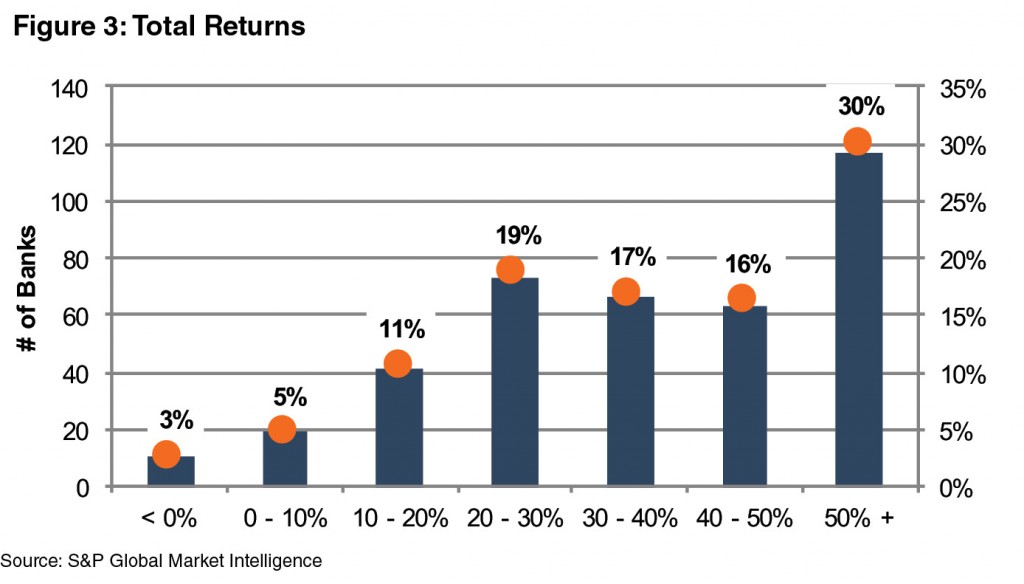
As shown in Figure 4, the median P/E for publicly-traded banks expanded about 30% to 20.6x trailing 12-month earnings at year-end from 15.9x at year-end 2015. Likewise, the median P/TBV multiple expanded to 181% from 140%. While bank stocks closed the year at the highest P/E level seen this century, P/TBV multiples remain below the pre-crisis peak given lower ROEs (ROTCEs), which in turn are attributable to higher capital and lower NIMs.
Figure 5 summarizes profitability by asset size. Banks with assets between $5 and $10 billion were the most profitable on an ROA basis and realized the highest total returns for the year. This group stands to benefit the most from regulatory reform if the Dodd-Frank $10 billion threshold (and $50 billion for SIFIs) is raised. In the most optimistic scenario, the market appears to be discounting that banks’ profitability will materially improve with lower tax rates, higher rates, and less regulation. The corollary to this is that the stocks are not as expensive as they appear because forward earnings will be higher provided credit costs remain modest. Based upon our review, most analysts have incorporated lower tax rates into their 2018 estimates, which accounts for much more modest P/Es based upon 2018 consensus estimates compared to 2017 consensus estimates.
2016 M&A Trends
On the surface, 2016 M&A activity eased modestly from 2014 and 2015 levels based upon fewer transactions announced; however, when measured relative to the number of banks and thrifts at the beginning of the year, 2016 was consistent with the long-running trend of 2-4% of institutions being acquired each year. The 246 announced transactions represented 3.8% of the 6,122 chartered institutions at the beginning of the year compared to 4.5% for 2014 and 4.2% for 2015.
As for pricing, median multiples softened a little bit, but we do not read much into that. Last year, the median P/TBV multiple for transactions in which deal pricing was disclosed eased to 136% compared to 142% in 2015; the median P/E based upon trailing 12 month earnings as reported declined to 21.2x versus 24.4x in 2015.
Elevated public market multiples since the national election have set the stage for higher M&A multiples in 2017 as publicly-traded buyers can “pay” a higher price with elevated share prices (Figure 8). The impact of this was seen among some larger transactions announced after the national election compared to when LOIs were announced earlier in the Fall. Activity may not necessarily pick-up with higher nominal prices, however, if would be sellers decide to wait for higher earnings as a result of anticipated increases in rates and lower taxes and regulations. In effect, some may wait for even better values or decide not to sell because ROEs improve sufficiently to justify remaining independent. Time will tell.
Figure 9 shows the change in deal multiples from announcement to closing and compares the change between deals announced and closed pre-election to those closed post-election. With the run-up in pricing, P/E and P/TBV multiples increased 12% and 9% from announcement to close compared to 4% and a decline of 1% pre-election.
2017 Outlook
No one knows what the future holds, although one can assess probabilities. An old market saw states “buy the rumor; sell the news” which means stocks move before the expected news comes to pass. As of the date of the drafting of this note (February 7), bank stocks are roughly flat in 2017. The stocks have priced in the likelihood of some roll-back in Dodd-Frank, higher short-term and long-term rates, lower tax rates, and a generally more favorable economic backdrop that supports loan growth and asset quality. The magnitude of these likely – but not preordained – outcomes and the timing are unknown. Following a big rally in 2016, returns for bank stocks may be muted in 2017 even if events in Washington and the Fed prove to be favorable for banks.
That said, higher stock prices and investor demand for reasonable yielding sub-debt from quality issuers implies the M&A market for banks should be solid. The one caveat is that there are fewer banks, so a healthy M&A market for banks could still entail fewer transactions than were recorded in 2016.
Mercer Capital is a national business valuation and financial advisory firm. Financial Institutions are the cornerstone of our practice. To discuss a valuation or transaction issue in confidence, feel free to contact us.
This article originally appeared in Mercer Capital’s Bank Watch, February 2017.
How to Create Strategic Value in the Current Environment
Against a backdrop of compressed net interest margins, enhanced competition from non-banks, rising regulatory and compliance costs and evolving consumer preferences regarding the delivery of financial services, many community banks find themselves at a significant inflection point where traditional growth strategies like building or acquiring an expansive, and often expensive, branch network are being reexamined.
In this session, we examined how banks can utilize a hybrid approach and co-opt, partner with or acquire FinTech companies, wealth management and trust operations and insurance brokerages. By pairing traditional banking services with other financial services and means of delivery, banks can obtain more touch points for customer relationships, enhance revenue and ultimately improve the bank’s valuation.
Andrew K. Gibbs, CFA, CPA/ABV, Senior Vice President, and Jay D. Wilson, CFA, ASA, CBA,Vice President, alongside Chris Nichols, Chief Strategy Officer at CenterState Banks, Inc. presented at Bank Director’s 2017 Acquire or Be Acquired Conference on January 30, 2017.
Creating Strategic Value Through Financial Technology
FinTech is not solely a threat to community banks—it’s an opportunity. Through successfully leveraging FinTech, community banks can level the playing field with larger banks and non-bank lenders, as they improve their profitability, performance, customer satisfaction, and value. Creating Strategic Value Through Financial Technology shows you how. The book contains 13 chapters broken into three sections:
- Section I introduces FinTech, examines its history and outlook, and also discusses key reasons that FinTech can have a significant positive impact on community banks in the U.S.
- Section II provides an overview of important trends and FinTech companies in prominent FinTech niches, such as bank technology, alternative (i.e., online) lending, payments (including blockchain technology), wealth management, and insurance. This section is helpful for community bankers interested in understanding more about particular FinTech niches.
- Section III presents a range of topics important to community bankers as they assess potential FinTech niches, partnerships, and acquisitions. Highlights include an examination of how to approach the build, buy, or partner decision when considering a FinTech niche or company; key return metrics to compare FinTech strategies to traditional strategies; and how community banks can value and structure potential partnerships, acquisitions, and investments in FinTech companies.
Creating Strategic Value through Financial Technology illustrates the potential benefits of FinTech to banks, both large and small, so that they can gain a better understanding of FinTech and how it can be leveraged to enhance profitability and create value for shareholders.
Order your copy today via Amazon, Barnes & Noble, Books-A-Million, or Wiley in hardcover or as an ebook.
EBITDA Single-Period Income Capitalization for Business Valuation
[Fall 2016] This article begins with a discussion of EBITDA, or earnings before interest, taxes, depreciation, and amortization. The focus on the EBITDA of private companies is almost ubiquitous among business appraisers, business owners, and other market participants. The article then addresses the relationship between depreciation (and
amortization) and EBIT, or earnings before interest and taxes, as one measure of relative capital intensity. This relationship, which is termed the EBITDA Depreciation Factor, is then used to convert debt-free pretax (i.e., EBIT) multiples into corresponding multiples of EBITDA. The article presents analysis that illustrates why, in valuation terms (i.e., expected risk, growth, and capital intensity), the so-called pervasive rules of thumb suggesting that many companies are worth 4.03to 6.03EBITDA, plus or minus, exhibit such stickiness. The article suggests a technique based on the adjusted capital
asset pricing model whereby business appraisers and market participants can independently develop EBITDA multiples under the income approach to valuation. Finally, the article presents private and public company market evidence regarding the EBITDA Depreciation Factor, which should facilitate further investigation and analysis.
[Reprinted from the American Society of Appraisers Business Valuation Review, Volume 35, Issue 3, Fall 2016]
Download the article in pdf format here.
Are Robo-Advisors on Any Banker’s Wish List?
Christmas appears to have come early for some bankers and their investors with the SNL Bank index up over 30% from the November 8, 2016 election to mid-December. While optimism abounds, one inconvenient truth remains for the time being: ROEs for the banking industry as a whole remain below pre-financial crisis levels despite credit costs that are below most historical standards. The factors challenging ROEs for the sector are numerous but include: compressed net interest margins from a historically low rate environment, enhanced competition from non-banks, a challenging regulatory and compliance environment, and evolving consumer preferences regarding the delivery of financial services.
These factors are particularly acute for most community banks that depend heavily on spread income and do not have the scale to absorb expense pressures as easily as their larger brethren. Further, many community banks are at a crossroad because their ROE consistently has fallen below the cost of capital, which in turn is forcing boards to consider strategic options like outright sales or potentially risky acquisition strategies to obtain scale.
In an ideal world, community banks could easily add fee businesses that are capital-light, such as wealth management and trust operations, to boost returns. By pairing traditional banking services with other financial services like wealth management, banks can obtain more touch points for customer relationships, enhance revenue, and potentially improve the bank’s valuation. While we have previously spoken about the potential benefits to community banks of acquiring or building out a traditional wealth management operation, we have not addressed emerging FinTech companies, like robo-advisors, that are focused on the wealth management space.
While there has been a race to partner and/or acquire robo-advisors by many of the larger asset managers and banks, there have also been some interesting partnerships with community banks. One such partnership struck is among Cambridge Savings Bank, a $3.5 billion bank located near Boston, and SigFig, a robo-advisor founded in 2007. While SigFig has relationships with UBS and Wells Fargo, its partnership with Cambridge Savings is notable because the two built a service called “ConnectInvest.“ When announced in the spring of 2016, the partnership was described as the “first automated investment service integrated and bundled directly into a retail bank’s product offerings in the U.S.” ConnectInvest, which is available to Cambridge’s customers digitally (mobile and website), “allows customers to easily open, fund, and manage an automated investment account tailored to their goals.” Cambridge’s customers are interested in the offering and have started using it. The goal is get up to 10% of its customer base using ConnectInvest.
With this example in mind, the remainder of this article offers an overview of the robo-advisory space for our community bank readers so that they may gain a better understanding of the key players and their service offerings and assess whether their bank could benefit from leveraging opportunities in this area.
An Overview of Robo-Advisors
Robo-advisors were noted by the CFA Institute as the FinTech innovation most likely to have the greatest impact on the financial services industry in the short-term (one year) and medium-term (five years). Robo-advisory has gained traction in the past several years as a niche within the FinTech industry by offering online wealth management tools powered by sophisticated algorithms that can help investors manage their portfolios at very low costs and with minimal need for human contact or advice. Technological advances that make the business model possible, coupled with a loss of consumer trust in the wealth management industry in the wake of the financial crisis, have created a favorable environment for robo-advisory startups to disrupt financial advisories, RIAs, and wealth managers. This growth is forcing traditional incumbents to confront the new entrants by adding the service via acquisition or partnership rather than dismiss it as a passing fad.
Robo-advisors have been successful for a number of reasons, though like many digital products low-cost, convenience, and transparency are common attributes.
- Low Cost. Automated, algorithm-driven decision-making greatly lowers the cost of financial advice and portfolio management.
- Accessible. As a result of the lowered cost of financial advice, advanced investment strategies are more accessible to a wider customer base.
- Personalized Strategies. Sophisticated algorithms and computer systems create personalized investment strategies that are highly tailored to the specific needs of individual investors.
- Transparent. Through online platforms and mobile apps, clients are able to view information about their portfolios and enjoy visibility in regard to the way their money is being managed.
- Convenient. Portfolio information and management becomes available on-demand through online platforms and mobile apps.
Consistent with the rise in consumer demand for robo-advisory, investor interest has grown steadily. While robo-advisory has not drawn the levels of investment seen in other niches (such as online lending platforms), venture capital funding of robo-advisories has skyrocketed from almost non-existent levels ten years ago to hundreds of millions of dollars invested annually the last few years. 2016 saw several notable rounds of investment into not only some of the industry’s largest and most mature players (including rounds of $100 million for Betterment and $75 million for Personal Capital), but also for innovative startups just getting off the ground (such as SigFig and Vestmark).
The table below provides an overview of the fee schedules, assets under management and account opening minimums for several of the larger robo-advisors. The robo-advisors are separated into three tiers. Tier I consists of early robo-advisory firms who have positioned themselves at the top of the industry. Tier II consists of more recent robo-advisory startups that are experiencing rapid growth and are ripe for partnership. Tier III consists of robo-advisory services of traditional players who have decided to build and run their own technology in-house.

As shown, account opening sizes and fee schedules are lower than many traditional wealth management firms. The strategic challenge for a number of the FinTech startups in Tiers I and II is generating enough AUM and scale to produce revenue sufficient to maintain the significantly lower fee schedules. This can be challenging since the cost to acquire a new customer can be significant and each of these startups has required significant venture capital funding to develop. For example, each of these companies has raised over $100 million of venture capital funding since inception.
Key Potential Effects of Robo-Advisory
We see five potential effects of robo-advisors entering the financial services landscape.
- Fee pressure. Robo-advisors may be a niche area for the time being, but the emergence and success of a technology-driven solution that challenges an age-old business (wealth management) epitomizes what has long been associated with internet (and digital) delivery of services: faster, better, and cheaper.
- The Democratization of Wealth Management. As a result of the low costs of robo-advisory services, new investors have been able to gain access to sophisticated investment strategies that, in the past, have only been available to high net worth, accredited investors.
- Holistic Financial Life Management. As more people have access to financial advice through robo-advisors, traditional financial advisors are being forced to move away from return-driven goals for clients and pivot towards offering a more complete picture of a client’s financial well-being as clients save for milestones such as retirement, a child’s education, and a new house. This phenomenon has increased the differentiation pressure on traditional financial advisors and RIAs, as robo-advisors can offer a holistic snapshot in a manner that is comprehensive and easy to understand
- Drivers of the Changing Role of the Traditional Financial Advisor. The potential shift away from return-driven goals could leave the role of the traditional financial advisor in limbo. This raises the question of what traditional wealth managers will look like going forward. One potential answer is traditional financial advisors will tackle more complex issues, such as tax and estate planning, and leave the more programmed decision-making to robo-advisors.
- Build, Buy, Partner, or Wait and See. As the role of the financial advisor changes, traditional incumbents like community banks are faced with determining what they want their relationship with robo-advisory to look like. In short, incumbents are left with four options: build their own robo-advisory in-house, buy a startup and adopt its technology, create a strategic partnership with a startup, or stay in a holding pattern in regard to robo-advisory and continue business as usual.
Robo-advisory is an exciting development for wealth managers and offers opportunities potentially for bankers to expand or develop their offerings in this area. Similar to any other growth strategy, the goal will ultimately be for the bank to enhance profitability and shareholder value by adding desired customer services.
For those bankers who may want to add a robo-advisor to their wish list, the key question of whether to build, buy, or partner is a challenging one. We will be speaking at the annual Acquire or Be Acquired (AOBA) conference in January on the topic of how to develop a framework to better assess this question. Additionally, for those who may go the investment route via a minority investment or outright acquisition, we offer some perspective on how to value and structure investments in FinTech companies like robo-advisors. Given the vast array of FinTech companies emerging in different areas of financial services, it will be important for bankers to develop a framework for both assessing potential opportunities and focusing in on those that provide the greatest potential to enhance profitability and shareholder value. We will post our slide deck from our AOBA session and make it accessible to BankWatch readers in the first quarter of 2017, so stay tuned.
Additionally, we have a new book coming in the spring of 2017 – Creating Strategic Value Through Financial Technology. In this book, we illustrate the potential benefits of FinTech to banks, both large and small, so that they can gain a better understanding of FinTech and how it can create value for their shareholders and enhance the health and profitability of their institutions.
As always, please do not hesitate to contact us if we can help in any way.
This article originally appeared in Mercer Capital’s Bank Watch, January 2017.
Use the Interim Time Between Now and the Future Sale of a Business to Wisely Prepare
Is business ownership a binary thing? Do we either own our businesses or not? The binary notion leads business owners to think either in terms of either the status quo or of an eventual sale of the business.
The truth is that between the two bookends of status quo and an eventual third-party sale are many possibilities for creating shareholder liquidity and diversification and facilitating both ownership and management transitions. We call this time “interim time.” The literal translation of “interim” from the original Latin means, “the time between.” Interim time, then, is the time between now, or the current status quo of a business, and an ultimate sale of that business. Let’s look at the bookends:
- Status Quo. First, let’s talk about the either. The status quo may be an excellent strategy. If sales and earnings are rising, existing owners can benefit from the growth and expected appreciation in value and maintain control of the business. However, the status quo, in many instances, does not provide liquidity and diversification opportunities for owners and places all execution risk on them. A decision to maintain the status quo for your business may not do much to advance necessary ownership and management transitions, as well. A decision to maintain the status quo should be based on conscious decision making and not on procrastination. And the status quo has an insidious side to it – unless you and the other owners do something, you will stay in the status quo for a long, long time; therefore, you have to question the status quo on an ongoing basis.
- Ultimate Third-Party Sale. Now, let’s talk about the or. If your business is continuing in a status quo mode, chances are you are not preparing it for an eventual sale. After all, it will happen someday, but not in the foreseeable future. Chances are also that you and the other owners may not be preparing yourselves for an eventual sale. And if you are maintaining a status quo status, you may not be able to influence the timing of an eventual sale. The ideal time to sell a business is when the markets are hot, when financing is readily available, when your business is tracking upward and has a good outlook, and when the owners are ready. In reality, what you can hope to achieve in a sale of your business is the best pricing available in the market at the time of the sale. If you remain in the status quo, you may not get to choose the timing of the eventual sale.If it seems like we are painting an eventual third party sale as an unfavorable outcome, we are not. It can result in an unfavorable outcome, however, if your business is not ready for sale at the given time and if you and your other owners are not ready, personally, for that eventual sale.
What to Do in the Interim Time
Managing illiquid, private wealth in private businesses is far more than running the businesses themselves. We all have to manage our businesses. Managing the wealth in our businesses requires a much more active role for business owners and often a different level of attention on the business itself.
The status quo and an eventual third-party sale are, indeed, bookends. Consider the table.
If we are managing the wealth in our closely held and family businesses, we will be focused on creating liquidity opportunities over time and on achieving reasonable returns from our companies on a risk-adjusted basis. We will be using our companies as vehicles to generate liquid wealth and diversification opportunities over time.
The table shows the bookends of status quo and third-party sale options. In between are a number of options that owners of successful private companies can use to manage the wealth tied up in them and to create ongoing opportunities for liquidity and diversification.
At the far right, after the sale of a business, its owners must, in many cases, be prepared for the rest of their lives. So it is important to run a business in such a way that its owners develop liquidity and diversification to create options for the rest of their lives.
The table is certainly not all inclusive, but it does include some easily implementable options like establishing a dividend/distribution policy or making occasional share repurchases as owners need some liquidity or, for example, when an owner leaves the company. This purchase might be pursuant to the terms of a buy-sell agreement.
If your company has significant excess assets, it is probably a good idea to clean up your balance sheet and declare a special dividend. And it may be appropriate to have one or more key managers acquire small stakes in the company to facilitate alignment and future management transitions.
I call these options “easily implementable,” but they won’t happen unless someone does something.
The next category of options in the table above are termed “significant and realistic minority options.” They include relatively small leveraged dividend recapitalizations or share repurchases. The options also might include the creation of a 30% or less ESOP in appropriate circumstances. These transactions certainly won’t happen without someone doing something. They will likely require the assistance of outside expertise, and there will be certain transaction costs. Transaction costs should be considered in the context of investments.
The third category after the status quo is called “control level options.” For some successful private companies, it may be appropriate to engage in substantial transactions to create liquidity opportunities and to retain ownership in expected future growth and appreciation. Options here include:
- Leveraged share repurchases
- Leveraged dividend recapitalizations
- Employee Stock Ownership Plans
The final category is the bookend of third-party sale transactions. It should now be clear that there are options other than selling a business today, or simply maintaining the status quo, for managing the illiquid wealth in your private company.
Benefits of Focusing on Interim Time
The shareholder benefits of employing one or more of the above strategies over time include the following:
- Acceleration of cash returns, liquidity opportunities, and opportunities for diversification and creating liquidity independent of your company
- Ability for your owners to diversify their portfolios
- Optimization of your company’s capital structure with reasonable leverage
- Enhanced return on equity with reasonable leverage
- Enhanced earnings per share for some options
- Planned changes in ownership structure with shareholder redemptions, with remaining owners achieving pickups in their relative ownership of the company
- Enhanced performance and reduced business risk with focus on the business
Employing one or more of the above The One Percent Solution strategies is tantamount to using modern investment theory concepts and basic corporate finance tools in the management of illiquid private company wealth.
For more information or to discuss a valuation and transaction issue in confidence, please do not hesitate to contact us.
Core Deposit Intangible Asset Values Remain Low
We ran an updated article in the October 2017 issue of Mercer Capital’s Bank Watch newsletter.
Other than goodwill, core deposit intangible assets are the most commonly recorded intangible assets in bank acquisitions, representing the benefit of having a low-cost, stable funding source. However, CDI values have decreased since the financial crisis, as deposits have less worth, so to speak, in a very low rate environment than in a “normal” environment that existed before the crisis. Using data compiled by S&P Global Market Intelligence, we analyzed trends in CDI assets recorded in whole bank acquisitions completed from 2008 through November 1, 2016. We compared CDIs recorded as a percentage of core deposits acquired to 5-year FHLB rates over the same period.
Since the start of the financial crisis, CDIs recorded in acquisitions have fallen from 1.5%-2.0% to stabilizing at approximately 1.0%-1.25% in the 2014-2016 period. As interest rates declined in the years following the crisis, the cheaper cost of alternative funds has made banks’ core deposit bases less valuable as a stable, cheap source of funding. Low rates also led to less attractive alternative investments for consumers, which has resulted in rising deposit balances and less competition for funds. In short, low rates have made funds easier and cheaper to access, reducing the value of core deposit intangible assets.
Despite the FOMC’s decision to begin a gradual increase in interest rates in late 2015, the cost of alternative funds such as FHLBs has not increased meaningfully since then. While the narrative around the economy and rates has shifted since the November 8th presidential election, it is unclear whether rates will increase more than the gradual pace the Fed has targeted since late 2015.
When interest rates were higher pre-crisis, both CDI levels and deposit premiums paid in acquisitions were higher than the levels observed in today’s environment. If rates do move meaningfully higher over the next few years, then deposit premiums should too (as would net interest margins).
Since the start of the financial crisis, improved deal values have resulted in some increase in deposit premiums paid in the past several years. However, the declining trend in CDI values has persisted even as deposit premiums have begun to tick back up.
For our analysis of industry trends in CDI values, we defined core deposits as total deposits, less accounts with balances over $100,000. In analyzing core deposit intangible assets for individual acquisitions, however, a more detailed analysis of the deposit base would consider the relative stability of various account types. In general, CDs tend to be more rate sensitive and less stable. Even in cases where a CD base is considered a stable customer base, given their relatively higher cost compared to non-time deposits, CDs often do not contribute to the core deposit intangible asset recorded. Furthermore, account types such as brokered or Qwickrate accounts and certain public funds that may be subject to a competitive bidding process are generally excluded from core deposits when determining the value of a CDI.
For more information about Mercer Capital’s core deposit services, feel free to contact us.
Valuation Implications of the Proposed Changes to Section 2704
In these handouts from a webinar presented September 26, 2016, Chris Mercer examined the proposed changes to regulations under IRS Code Section 2704 from a business valuation perspective.
The express goal of the Proposed Changes is to eliminate, or virtually so, valuation discounts in family partnerships (and operating companies, as well). The instruments of change are a loosened definition of control (to broaden the number of families having control), almost total family attribution of control for every transfer, and a hypothetical put right to the partners in family partnership to facilitate the elimination or reduction of valuation discounts in fair market value determinations.
A review from business and valuation perspectives finds that the Proposed Changes, if adopted as published, will affect, but not eliminate valuation discounts.
The webinar covered the following:
- The concept of control
- “Applicable restrictions”
- “Disregarded restrictions”
- The put right
- Fair market value?
- Hypothetical appraisals
- An example from the Proposed Changes
To view the recording of this webinar, click here.
For more information about the Proposed Changes, see our whitepaper on the topic.
Valuation Implications of the Proposed Changes to Section 2704 Webinar
In this webinar presented September 26, 2016, Chris Mercer examined the proposed changes to regulations under IRS Code Section 2704 from a business valuation perspective.
The express goal of the Proposed Changes is to eliminate, or virtually so, valuation discounts in family partnerships (and operating companies, as well). The instruments of change are a loosened definition of control (to broaden the number of families having control), almost total family attribution of control for every transfer, and a hypothetical put right to the partners in family partnership to facilitate the elimination or reduction of valuation discounts in fair market value determinations.
A review from business and valuation perspectives finds that the Proposed Changes, if adopted as published, will affect, but not eliminate valuation discounts.
The webinar covered the following:
- The concept of control
- “Applicable restrictions”
- “Disregarded restrictions”
- The put right
- Fair market value?
- Hypothetical appraisals
- An example from the Proposed Changes
For more information about the Proposed Changes, see our whitepaper on the topic.
Session Archive
5 Trends to Watch in the Medical Device Industry in 2016
Medical Device Overview
The medical device manufacturing industry produces equipment designed to diagnose and treat patients within global healthcare systems. Medical devices range from simple tongue depressors and bandages, to complex programmable pacemakers and sophisticated imaging systems. Major product categories include surgical implants and instruments, medical supplies, electro-medical equipment, in-vitro diagnostic equipment and reagents, irradiation apparatuses, and dental goods.
The following outlines five structural factors and trends that influence demand and supply of medical devices and related procedures.
1. Demographics
The aging population, driven by declining fertility rates and increasing life expectancy, represents a major demand driver for medical devices. The U.S. elderly population (persons 65 and above) totaled 48 million in 2015 (15% of the population). The U.S. Census Bureau estimates that the elderly will roughly double by 2060 to 98 million, representing 24% of the total U.S. population.
The elderly account for nearly one third of total healthcare consumption. Personal healthcare spending for the 65 and above population segment was $19,000 per person in 2012, five times the spending per child ($3,600) and almost triple the spending per working-age person ($6,600).
According to United Nations projections, the global elderly population will rise from 608 million (8.3% of world population) in 2015 to 1.8 billion (18.1% of world population) in 2060. Europe’s elderly are projected to reach 28% of the population by 2060, making it the world’s oldest region. While Latin America and Asia are currently relatively young, these regions are expected to experience drastic transformations over the next several decades, with the over 65 population segments expected to expand from 8% in 2015 to more than 23% of the total population by 2060.
2. Healthcare Spending and the Legislative Landscape in the U.S.
Demographic shifts underlie the expected growth in total U.S. healthcare expenditure from $3.2 trillion in 2015 to $5.6 trillion in 2025. Healthcare spending as a percentage of GDP is also expected to expand from 17% in 2015 to over 20% by 2025.
Since inception, Medicare has accounted for an increasing proportion of total U.S. healthcare expenditures. Medicare currently provides healthcare benefits for an estimated 57 million elderly and disabled Americans, constituting approximately 15% of the federal budget in 2015. Medicare represents the largest portion of total healthcare costs, constituting 20% of total health spending in 2014. Medicare also accounts for 26% of hospital spending, 29% of retail prescription drugs sales, and 23% of physician services.
Owing to the growing influence of Medicare in aggregate healthcare consumption, legislative developments can have a potentially outsized effect on the demand and pricing for medical products and services. Net outlays to the four parts of Medicare totaled $540 billion in 2015, and spending is expected to reach $709 billion by 2020. Between 2000 and 2010, growth in Medicare spending per capita was comparable or lower than private health insurance spending.
The Patient Protection and Affordable Care Act (“ACA”) of 2010 incorporated changes that are expected to constrain annual growth in Medicare spending over the next several decades by curtailing increases in Medicare payments to healthcare providers, and establishing several new policies and programs designed to reduce costs. On a per person basis, Medicare spending is projected to grow at 4.3% annually from 2015 and 2025, compared to 5.7% average annualized growth realized from 2000 to 2014.
As part of ACA legislation, a 2.3% excise tax was imposed on certain medical devices for sales by manufacturers, producers, or importers. The 2.3% levy was expected to net nearly $30 billion over a decade into the early 2020s. The tax became effective on December 31, 2012, but met resistance from industry participants and policy makers. In July of 2015, the U.S. House of Representatives voted to repeal the medical device tax. In late 2015, Congress passed legislation promulgating a two-year moratorium on the tax beginning January 2016.
3. Third-Party Coverage and Reimbursement
The primary customers of medical device companies are physicians (and/or product approval committees at their hospitals), who select the appropriate equipment for consumers (the patients). In most developed economies, the consumers themselves are one (or more) step removed from interactions with manufacturers, and therefore pricing of medical devices. Device manufacturers typically receive payments from insurers, who usually reimburse healthcare providers for routine procedures (rather than for specific components like the devices used). Accordingly, medical device purchasing decisions tend to be largely disconnected from price.
Third-party payors (both private and government programs) are keen to reevaluate their payment policies to constrain rising healthcare costs. Several elements of the ACA are expected to limit reimbursement growth for hospitals, which form the largest market for medical devices. Lower reimbursement growth will likely persuade hospitals to scrutinize medical purchases by adopting i) higher standards to evaluate the benefits of new procedures and devices, and ii) a more disciplined price bargaining stance.
The transition of the healthcare delivery paradigm from fee-for-service (FFS) to value models is expected to lead to fewer hospital admissions and procedures, given the focus on cost-cutting and efficiency. In 2015, the Department of Health and Human Services (HHS) announced goals to have 85% and 90% of all Medicare payments tied to quality or value by 2016 and 2018, respectively, and 30% and 50% of total Medicare payments tied to alternative payment models by the end of 2016 and 2018, respectively. In March 2016, the HHS estimated 30% of Medicare payments were tied to alternative, value-based models, nearly one year ahead of schedule. Ultimately, lower reimbursement rates and reduced procedure volume will likely limit pricing gains for medical devices and equipment.
The medical device industry faces similar reimbursement issues globally. A number of countries have instituted price ceilings on certain medical procedures, which could deflate the reimbursement rates of third-party payors, forcing down industry product prices. Whether third-party payors consider certain devices medically reasonable or necessary for operations presents a hurdle that device makers and manufacturers must overcome in bringing their devices to market.
4. Competitive Factors and Regulatory Regime
Historically, much of the growth for medical technology companies has been predicated on continual product innovations that make devices easier for doctors to use and improve health outcomes for the patients. Successful product development usually requires significant R&D outlays and a measure of luck. However, viable new devices can elevate average selling prices, market penetration, and market share.
Government regulations curb competition in two ways to foster an environment where firms may realize an acceptable level of returns on their R&D investments. First, firms that are first to the market with a new product can benefit from patents and intellectual property protection giving them a competitive advantage for a finite period. Second, regulations govern medical device design and development, preclinical and clinical testing, premarket clearance or approval, registration and listing, manufacturing, labeling, storage, advertising and promotions, sales and distribution, export and import, and post market surveillance.
Regulatory Overview in the U.S.
In the U.S., the FDA generally oversees the implementation of the second set of regulations. Some relatively simple devices deemed to pose low risk are exempt from the FDA’s clearance requirement and can be marketed in the U.S. without prior authorization. For the remaining devices, commercial distribution requires marketing authorization from the FDA, which comes in primarily two flavors.
- The premarket notification (“510(k) clearance”) process requires the manufacturer to demonstrate that a device is “substantially equivalent” to an existing device that is legally marketed in the U.S. The 510(k) clearance process may occasionally require clinical data, and generally takes between 90 days and one year for completion.
- The premarket approval (“PMA”) process is more stringent, time-consuming and expensive. A PMA application must be supported by valid scientific evidence, which typically entails collection of extensive technical, preclinical, clinical and manufacturing data. Once the PMA is submitted and found to be complete, the FDA begins an in-depth re- view, which is required by statute to take no longer than 180 days. However, the process typically takes significantly longer, and may require several years to complete.
Pursuant to the Medical Device User Fee Modernization Act (MDUFA), the FDA collects user fees for the review of devices for marketing clearance or approval, as well as establishment registration. The current iteration of the act, MDUFA III, was enacted in 2012 and expected to collect approximately $400 million in user fees over five years. The FDA and the medical device industry have reached a broad agreement on the outlines of the next iteration. The FDA is expected to collect nearly $1 billion in user fees over five years pursuant to MDUFA IV, which would go into effect in in October 2017.
Regulatory Overview Outside the U.S.
The European Union (EU), along with countries such as Japan, Canada, and Australia all operate strict regulatory regimes similar to that of the U.S. FDA, and international consensus is moving towards more stringent regulations. Stricter regulations for new devices may slow release dates and may negatively affect companies within the industry.
Medical device manufacturers face a single regulatory body across the EU, the Company’s second largest end market behind the U.S. In order for a medical device to be allowed on the market, it must meet the requirements set by the EU Medical Devices Directive. Devices must receive a Conformité Européenne (CE) Mark certificate before they are allowed to be sold on the market. This CE marking verifies that a device meets all regulatory requirements for the EU, and that they meet EU safety standards. A set of different directives apply to different types of devices, and the device must be compliant with the directive that purviews it.
5. Emerging Global Markets
Emerging economies are claiming a growing share of global healthcare consumption, including medical devices and related procedures, owing to relative economic prosperity, growing medical awareness, and increasing (and increasingly aging) populations. As global health expenditure continues to increase, sales to countries outside the U.S. represent a potential avenue for growth for domestic medical device companies. According to the World Bank, all regions (except Sub-Saharan Africa) have seen an increase in healthcare spending as a percentage of total output over the last two decades.
Global medical devices sales are estimated to increase 6.4% annually from 2016 to 2020, reaching nearly $440 billion according to the International Trade Administration. While the Americas are projected to remain the world’s largest medical device market, the Asia and Pacific and Western Europe markets are expected to expand at a quicker pace over the next several years.
Summary
Demographic shifts underlie the long-term market opportunity for medical device manufacturers. While efforts to control costs on the part of the government insurer in the U.S. may limit future pricing growth for incumbent products, a growing global market provides domestic device manufacturers with an opportunity to broaden and diversify their geographic revenue base. Developing new products and procedures is risky and usually more resource intensive compared to some other growth sectors of the economy. However, barriers to entry in the form of existing regulations provide a measure of relief from competition, especially for newly developed products.
An Overview of the Medical Device Industry
This presentation presents a broad outline of the medical device industry, which is characterized by:
- Continual technological advancement.
- High profitability.
- Sustained growth.
Typically, a device begins life as discovery of a new material or novel technology that addresses a gap in treatment or facilitates a better approach to patient care. Successful development of a device occurs along three dimensions, i) efforts to demonstrate the product causes no harm and improves patients outcomes culminate in regulatory approval or clearance, ii) insurers accept value by acceding to reimburse product and related procedures, and iii) purchasers and consumers adopt at a sufficient enough commercial scale. The tri-fold development requirements represent a significant barrier to new entrants. As with other technologies, however, devices tend to have finite life-spans as patents expire, and newer products further improve upon incumbent solutions.
Pricing tends to be divorced from the purchasing decisions as buyers’ (physicians’) decisions do not depend (primarily) on price, consumers (patients) largely purchase insurance coverage and do not directly pay for the device, are payers (insurers) are a step removed from the prescription and delivery of care services.
As with many other healthcare sub-segments, demographic shifts and global economic trends underlie sustained growth expected in the market for medical devices.
Characteristics of a Good Buy-Sell Agreement
The creation of buy-sell agreements involves a certain amount of future-thinking. The parties must think about what could, might, or will happen and write an agreement that will work for all sides in the event an agreement is triggered at some unknown time in the future. This article addresses the important characteristics of buy-sell agreements that are important for business owners and for attorneys advising them.
What Do Buy-Sell Agreements Do?
Buy-sell agreements are entered into between corporations and their shareholders to protect companies against disruptive, harmful, or nonproductive owners (including divorced spouses, competitors, disgruntled former employees and the like). They also provide protections for shareholders who may, for any number of reasons, depart the company. The estates of deceased owners need protection, as do shareholders who have been terminated, with or without cause.
It is important that buy-sell agreements be entered into while the interests of the parties (the corporation and the shareholders) are aligned, or at least not sufficiently misaligned, that they cannot discuss the business and valuation aspects of their buy-sell agreements. To the extent possible, attorneys should encourage parties to enter into buy-sell agreements or to review their agreements and update them if they are out of date or circumstances have changed.
What is known for certain is that once a trigger event has occurred, the interests of the parties (i.e., the buyer(s) and the seller(s)) diverge and agreement over the pricing and terms of necessary transactions can become difficult or impossible to achieve.
Characteristics of a Good Buy-Sell Agreement
From valuation and other business perspectives, buy-sell agreements generally incorporate several important aspects defining their operation. The list of characteristics of successful buy-sell agreements below is taken from my book, Buy-Sell Agreements for Closely Held and Family Business Owners.
Require agreement at a point in time (before trigger events or other dissension) among shareholders of a company and/or between shareholders and the company.
It may seem obvious, but if there is no agreement between the shareholders and the company, then there is no buy-sell agreement. Such agreements must be evidenced by a writing of the agreement and by the signatures of all parties who will be subject to the agreement. Agreement is not always easy to obtain. Shareholders have different backgrounds, financial positions, personal outlooks, and involvement with a business, so agreement is not automatic. However, it is important that attorneys continue to work with clients to encourage agreement and that business owners remain committed to reaching agreement and signing their buy-sell agreements.
The point in time at which agreement is reached is the date of the signing of each particular buy-sell agreement.
Relate to transactions that may or will occur at future points in time between the shareholders, or between the shareholders and the corporation.
When the shareholders of a new venture come together to discuss a buy-sell agreement, it is foreseeable that many things can happen that will trigger the operation of a buy-sell agreement. Owners may quit, one may be fired, another may retire, one could die, still another could become divorced, and another could become bankrupt — to name a few.
The owners can discuss these future potential trigger events and which ones they want to include specifically in their buy-sell agreements. It is important that all owners think seriously about these issues because, at the time a buy-sell agreement is being drafted, no one knows what might happen to him or to her or to any of the other owners. In other words, no one knows who will be a buyer and who will be a seller.
When the owners of an existing enterprise come together to review their buy-sell agreement, they may know that some of the above-mentioned events have already happened in the lives of their fellow owners. They will know if the buy-sell agreement operated satisfactorily, or was triggered at all.
For all owners of all enterprises, discussions about buy-sell agreements reflect a form of future thinking, which is sometimes (perhaps always) difficult. As Yogi Berra famously said: “The future’s hard to predict. It hasn’t happened yet.”
Choices have to be made regarding buy-sell agreements. Ignoring the importance of these documents because it is difficult to future think about them is one choice. Based on over thirty years of working with businesses and business owners, ignoring the issue is not a good choice.
Define the conditions that will cause the buy-sell provisions to be triggered. Most often, business owners think of death as the most likely trigger event for buy-sell agreements. It is actually the least frequent trigger event for most companies.
Trigger events have to be defined specifically. Death is fairly obvious. However, firings can be with or without cause, and agreements may need to specify what happens in each circumstance. The parties to an agreement must future think a bit to anticipate what could happen and document the agreement appropriately. If this sounds like work, it is.
Determine the price at which the identified future transactions will occur (as in price per share, per unit, or per member interest). Because of the diverging interests of parties following trigger events, this is one of the hardest parts of establishing effective buy-sell agreements. This is why many appraisers and other advisers to closely held businesses recommend appraisal with a pre-determined appraiser as a generally preferable pricing mechanism for substantial business enterprises.
There are buy-sell agreements with fixed prices. Unfortunately, these agreements are seldom updated and are ticking time bombs. For a poster child example of what can happen with fixed price agreements, read here.
Other buy-sell agreements contain formula pricing provisions. Unfortunately, we haven’t seen a formula yet that can reasonably value any company over time with changing conditions at the company, within its industry and markets, in the local, regional or national economies, and in all market conditions and interest rate environments.
Then, there are what we call valuation process agreements, which provide for a valuation process to determine the price. Many agreements have an embedded multiple appraiser process which will not be exercised until the occurrence of a trigger event. These agreements, too, are fraught with potential pitfalls.
We assert that the best pricing mechanism for most buy-sell agreements of successful closely held and family businesses is a single appraiser process where the appraiser is selected by the parties at the outset and provides an appraisal to determine an agreement’s initial pricing. The appraiser is then asked to provide reappraisals each year (or every other year at most) to reset the price for the buy-sell agreement.
Determine the terms under which the price will be paid.
Many buy-sell agreements call for the price determined under their terms to be paid by the issuance of a promissory note by the company. Quite often, the price determined by appraisal will be the fair market value of the interest. However, many notes defined in buy-sell agreements are not worth par, or their face amounts, so recipients end up getting less than fair market value for their interests.
A promissory note might be worth less than par if it has a below market interest rate for notes of comparable risk. Often, there is no security for promissory notes issued in connection with buy-sell agreements, and no protection against future financings that are subordinated, leaving the promissory note less protected.
Provide for funding so the contemplated transactions can occur on terms and conditions satisfactory to selling owners and the corporation (or other purchasing owners). This element is important and often overlooked.
Life insurance is often considered as a funding mechanism for buy-sell agreements. One big problem is that the only time that life insurance is received is when an insured owner dies. However, death is the least likely trigger event for most companies. Firings, retirings, divorcings, disabilities, and other things happen with far greater frequency.
Funding may come from a promissory note as discussed above. It can also come from outside financing if the company is able to obtain such financing. Sinking funds have their own issues, because a selling shareholder was present while any sinking fund was accumulated, and would likely desire to share in its value.
Satisfy the business requirements of the parties. While buy-sell agreements have much in common, each business situation is different, and unique parties are involved. In the end, legal counsel must draft buy-sell agreements to address the business issues that are important to the parties. Clearly, establishing and agreeing on the key business issues and having them reflected in the agreement can be difficult. If the owners do not reach agreement on key business issues, no attorney can draft a reasonable document for the parties.
All of the potential trigger events discussed above are business issues (and personal issues) for business owners. Other business issues could include the maintenance of relative ownership between groups of shareholders, the admission of additional shareholders, and other issues that may or not relate directly to potential future trigger events. Some family businesses add clauses in the event of a shareholder’s divorce to preclude the shares from being granted to a divorcing spouse who is not of direct lineal descent of the family.
Provide support for estate tax planning for the shareholders, whether in family companies or in non-family situations.
One client of many years has a buy-sell agreement and the family has engaged in significant gift and estate tax planning. Several years ago, the gift tax returns of the owners of a client company were audited. Agreement could not be reached with the Internal Revenue Service, and the matter proceeded on a path towards Tax Court. One of the key issues in dispute was whether the buy-sell agreement met the requirements of IRS Code Section 2703 (b). After much discussion and preparation for trial, agreement was reached that the buy-sell agreement withstood the exceptions (subparagraph (b)) to the general rule of Code Section 2703:
(b) Exceptions
Subsection (a) shall not apply to any option, agreement, right, or restriction which meets each of the following requirements:
(1) It is a bona fide business arrangement.
(2) It is not a device to transfer such property to members of the decedent’s family for less than full and adequate consideration in money or money’s worth.
(3) Its terms are comparable to similar arrangements entered into by persons in an arms’ length transaction.
As part of the preparations for trial, I was asked to render a supplemental report on behalf of Mercer Capital to assist the court in analyzing the relevant shareholder agreements from business and valuation perspectives. Fortunately, the case settled on the eve of trial with agreement that the relevant agreement satisfied the requirements, and with settlement at the conclusions of fair market value issued by Mercer Capital for the relevant years. The issues raised by the relationship of buy-sell agreements and estate planning are important.
Satisfy legal requirements relating to the operation of the agreements. Buy-sell agreements must be drafted such that they are legally binding on the parties to them. In addition, agreements must be drafted to comply with laws and/or regulations that may be applicable to their operation. Business owners must rely on legal counsel regarding such matters.
Business owners must agree on the business and valuation issues relevant to their buy-sell agreements. However, those agreements must be memorialized by competent legal counsel, who should be involved in the discussions to begin with, together with estate planning counsel, other financial advisers and a qualified business appraiser.
Conclusion
Buy-sell agreements are business and legal documents that are created in the context of business, valuation and legal requirements. We need to engage in future thinking in order that our agreements will withstand not only the tests of time, but also potential challenges from the Internal Revenue Service.
An Investor’s View of Major League Sports Franchises: Outsized Returns or a Risky Play?
This following article was originally published by The Texas Lawbook.
It has been often discussed, particularly in recent years, that the value of privately held professional sports franchises is a newsworthy item. Analysts, investors, and fans alike have an interest in observing team owners buy and sell teams and watch the prices at which they trade. However, are team owners doing as well as some may portray? How about their investments as compared to their investing peers in the stock markets.
We attempt to answer these questions based on some known data sources and return analytics over time. The answers are interesting but not entirely clear.
There are two components to an investor’s rate of return: (i) interim returns in the form of cash flows or dividends, and (ii) price appreciation. Many commentators and writers have noted that some major league sports franchises have incurred operating losses in past years. For example, at one point it appeared that the MLB franchises on average had operating losses as players’ salaries increased faster than revenues. This was a big factor underlying the NFL and NHL lockouts in 2011 and 2012. There is a silver lining, however, and that appears to be the price appreciation realized from the increased values of these major league franchises.
We traced over time the estimated appreciation (by league) of the values of sports teams, according to Forbes magazine. We also tracked the returns over the same time frames of several familiar equity market indices. The table below summarizes our findings.
We tracked this data going all the way back to 1991. We then sorted the returns over different decades – the 1990s, the 2000s, and our current decade. We aggregated it for the 25 total years of data.1
We observe that equity markets outperformed league appreciation in the 1990s, but the leagues caught up in the 2000s and 2010s. The biggest reason for the significant increase in the 2000s and the 2010s (among others) is television contracts – specifically, increases in national TV contracts for the NFL and NBA and regional and local contracts for MLB and NHL (and to a lesser degree the NBA as well).
Consider a few examples:
- The NFL had its national TV contract increase dramatically in the last several renewals, most significantly, the most recent one. The 2014 season was the first year of the NFL’s nine-year deal with Fox, CBS, and NBC. The networks will pay about $3.1 billion in rights fees every season or 63% more than the previous TV deal.
- The NBA, which signed a nine-year deal with ESPN and Turner Broadcasting and other networks, had total fees worth $24 billion in 2014. This skyrocketed to $3.6 billion a year, up from about $930 million in the contracts reached in 2007. In addition, NBA teams have benefited from increased local TV rights that have usually doubled or even tripled in annual rights fees in the last 5 years.
- For MLB and NHL teams, the majority of the TV revenue comes from local TV contracts. These contracts have also appreciated substantially in the last five years increasing 3 to 5 times in comparison to the contracts signed 5 to 7 years ago.
This increased TV revenue has been the primary driver of the very strong price appreciation in the 2000s and particularly in last five years (2011-2016).
In the last five years (2011-2016), the MLB team values have increased on average 19.8% compounded according to Forbes. The NBA Forbes value estimates increased by 27.6% for the same period. The NFL increased 17.4% and the NHL 21.3%. This short 5-year period has seen the highest percentage increase in the last 25 years. The compounded increases are 10% to 13% for the four major sports leagues over a 25-year period (1991-2016). In comparison, the DOW increased 7.4% compounded, the NASDQ 10.1% the S&P 500 7.0% and the Russell 2000 8.2%.
Therefore, solely from an appreciation point of view, an investment in a major league sports franchise appears to have been a very good return in the last 25 years, especially in the last five years. Of course, these returns vary by team and nothing is guaranteed. It is also notable that some teams have incurred operating losses that will offset a significant amount of the total return. This can impact investments in the form of debt or even capital calls from investors. This gets even more complicated when considering the value of minority interests in teams whereby the ability to monetize their returns is more uncertain. In fact, minority interests typically trade (however infrequently) at lower value levels than what the pro-rata value of a franchise would otherwise be worth. Therefore, appreciation returns that appear positive can come with drawbacks as well. Critical analysis is important to investors to help them determine if their returns are worth the risks.
Mercer Capital has arguably the most expertise in sports valuation and related stadium advisory in the country. For more information, contact one of our professionals.
End Note
1 We would note that Forbes does not have access to many team financials as teams are closely held (with the notable exception of the Green Bay Packers).Forbes relies on limited data and educated estimates of actual revenues and profits in order to make their estimated values.This is a limiting factor to properly value a single franchise at a single point in time.That said, as part of Forbes’ analysis they have interview access to a number of team owners to test the reasonableness of their valuations and key assumptions.In addition, their estimated values are adjusted year-to-year to account for actual sale prices of teams that sell.This is helpful when observing estimated aggregate values over a long period of time.
Three Reasons to Consider a Valuation of Your FinTech Company
“Nowadays people know the price of everything and the value of nothing.”
– Oscar Wilde, The Picture of Dorian Gray
The above quote seems especially apt in the FinTech industry because the implied values of high-profile, private FinTech companies are often mistakenly reported by the media based on the share price paid by investors in a recently completed funding round. The problem with applying the pricing of the most recent raise to all shares is that the media rarely knows about investor preferences attributable to each funding. As a result, the value of the company is most likely overstated. Capital structures and shareholder preferences matter. Pari passu is not a given although it is often implicitly implied in media reports.
Consider the following example. Investors in a late-stage funding invest $100 million in return for 100,000 convertible preferred shares that represent 10% of the company’s post-raise fully diluted shares. The investors also get certain economic, control rights and other preferences with their preferred shares that earlier investors did not obtain. The headline notes that a new FinTech Unicorn has arrived because the implied value is $1 billion based upon the $100 million investment for the 10% interest; however, this simple calculation typically will overstate the Company’s value because the majority of the shares do not have the same rights and preferences as those purchased in the most recent financing round.
Valuing companies with limited if any operating history that involves a new technology is inherently difficult. The challenge increases when the subject has a complex capital structure. Nevertheless, valuations—whether reasonable or unreasonable—have very real economic consequences for investors, employees and other stakeholders, especially when new capital is injected into the equation. We are biased, but we believe private FinTech companies will be well served over the long-run to obtain periodic valuations from independent third parties. Reasons to do so include the following.
1. To Measure Value Creation Over Time
One of the best performance scorecard metrics to measure is value creation over extended time periods. For public companies, it is a simple process. Measure a company’s total return (percentage change in share price plus the return from reinvested dividends) and compare it to other benchmark measures such as the broader market, industry, and/or peers. For example, a publicly traded payments company whose shareholders have achieved a one-year total return of 10.0% can note on their scorecard that their performance has outpaced the returns from the S&P 500 and Mercer Capital’s FinTech Payments Index, which rose 4.0% and 4.6%, respectively, in the twelve months ended June 30, 2016.
For private companies, annual or more frequent valuations have to be obtained to create a realistic scorecard. Rules-of-thumb exist in every industry, but they are at best approximations and often haphazard guesses that do not take into account the key value drivers of earning power (or cash flow generation), growth, and risk. Some privately held financial services companies like banks may be able to proxy value creation without annual valuations by tracking growth in book value, ROE, and dividend payments, but even for homogenous entities such as banks these metrics say nothing about an institution’s risk profile. FinTech companies with little homogeneity among business models are poorly suited to measure value based upon rules-of-thumbs that are applied to revenues or even EBITDA. Every company is unique, and markets in which companies are valued are not static.
Also, there may be a tendency to overlook balance sheets beyond cash because FinTech balance sheets typically do not “drive” earning power as intangible assets, such as customer databases, intellectual property, patents, and the like, are not recorded unless there has been an acquisition. While understandable, ignoring the balance sheet can be a mistake because sometimes there are aspects to it that will impact value.
Additionally, dividends (the other element of shareholder return) and dividend paying capacity should be an important value consideration, even though FinTech companies often do not or cannot pay dividends in order to reinvest internally generated capital to fund future growth. Another benefit of the valuation process might be insight that suggests the board should shift to distributions from reinvestment because incremental returns are too low to justify.
It is advisable for private FinTech companies to measure value creation by having annual or more frequent valuations performed by an outside third-party. For example, consider Table 1 for Private FinTech Company that tracks returns to shareholders based upon changes in the appraised value of the shares and dividends paid over a three-year period. While the hypothetical 45% total return outwardly appears attractive, there is no context. Comparisons with publicly traded FinTech companies, broad industry indexes and realized returns following an acquisition for public and private companies will provide further relevance to the scorecard (Chart 1).
2. For Planning Purposes
Projections for an early-stage FinTech company are a given. In theory so too are rising valuations as important milestones, such as targeted market penetration, users, revenues, and EBITDA, are met. Unless the company does not require significant capital and/or internal capital generation is sufficient, the projections should incorporate additional capital raises and expected dilution based upon implicit valuations. On a go forward basis periodic valuations can be overlaid with the initial and any refreshed forecasts to measure how the company is progressing in terms of value creation relative to plan and to alternatives (e.g., a strategy pivot to a collaborative partnership from disruptor). The key is to measure and compare in order to have a contextual perspective to facilitate decision making.
3. For Employee Ownership Plans
FinTech companies usually attract talent by offering stock ownership so that employees share in the upside should the company’s valuation improve over time. Plus, stock-based compensation lessens a company’s cash needs all else equal. Complex capital structures with private equity investors that have preferences vis-a-vie employees create another potential valuation wrinkle. Returns to the two groups usually will differ. Well documented, periodic valuations are critical. There have been examples where employees have lost money by paying taxes based upon valuations higher than the company realized in a sale. While downside exposure to a company’s faltering performance and/or market conditions is the risk that comes with the potential upside of equity ownership, it is important to have a formalized valuation process to demonstrate compliance with tax and financial reporting regulations. Certainly, scrutiny from auditors, the SEC, and/or the IRS are likely at some point, but very real tax issues also can result from poorly structured or administered equity compensation plans for employees.
Conclusion
If you are interested in discussing the valuation needs for your FinTech company, please contact us. Depending upon how it is defined FinTech is a relatively new industry “vertical.” Mercer Capital has been providing valuation and transaction advisory services to a wide swath of financial services companies for over 30 years that runs the gamut from banks to FinTech. Financials are our largest practice vertical. We have a deep bench and would be delighted to assist.
This article originally appeared in the Second Quarter 2016 issue of Mercer Capital’s Value Focus: FinTech newsletter.
Learn More
Does Fair Market Value (and its Associated Discounts) Avoid the Intent of 2704 and Thus “Undervalue” Certain Types of Transferred Interests?
[August 2016] The IRS released its long expected proposed regulations in regards to Section 2704 on August 2. The substance of this proposal, according to the IRS, is to regulate treatment of entities for estate and gift tax purposes. According to the summary the proposal is:
“…concerning the valuation of interests in corporations and partnerships for estate, gift, and generation-skipping transfer (GST) tax purposes. Specifically, these proposed regulations concern the treatment of certain lapsing rights and restrictions on liquidation in determining the value of the transferred interests. These proposed regulations affect certain transferors of interests in corporations and partnerships and are necessary to prevent the undervaluation of such transferred interests.”
Before we delve any deeper on this article, let’s clarify a few things up front:
- We are appraisers, not lawyers and we are neither qualified nor particularly interested in dissecting the proposal from a legal perspective. Our friends in the legal community can address that.
- This is a proposal that, as of the writing of this article, is not in effect, could change, or might never go into effect. (Nonetheless we aim to comment from a valuation perspective as if it does).
With that said – what we hope to do in this post is to (i) give readers some context about the impetus of these proposed Section 2704 changes, (ii) share what these proposed changes are, and (iii) share what this might mean from a valuation standpoint.
Background of the Proposal
According to the IRS, treatment by taxpayers in regards to certain rights and transfers, as well as rulings of the Tax Court in regards to these rights and transfers have allowed taxpayers to avoid application of Section 2704. Representative of this sentiment, Page 6 of the proposal puts it this way when referencing Section 2704(b):
“The Treasury Department and the IRS have determined that the current regulations have been rendered substantially ineffective in implementing the purpose and intent of the statute by changes in state laws and by other subsequent developments.”
The areas that the IRS cites as no longer ineffective fall into three primary areas:
- 2704(a). Specifically the area covering so-called “Deathbed Transfers” – whereby liquidation rights lapse upon death. The IRS cites Estate of Harrison v. Commissioner as an example of this. The IRS claims that such transfers generally have minimal economic effects, but result in a transfer tax value that is based on less than the value of the interest.
- 2704(b). Inter-family transfers and specifically restrictions on liquidation for family interest transfers. Reasons for this include that courts have concluded that Section 2704 applies to restrictions on the ability to liquidate an entire entity, and not on the ability to liquidate a transferred interest in that entity. Also the IRS says state laws and utilization of “assignees” have allowed taxpayers avoid 2704.
- 2704(b). Granting of insubstantial interests to non-family members (such as a charity or employee) to avoid application of the statute. The IRS says this needs to be changed, because, in reality, such non-family interests generally do not constrain a family’s ability to remove a restriction on an individual interest.
Proposed Changes and Amendments
In light of this perceived avoidance and ineffectiveness of certain provisions in 2704, the IRS has proposed a number of new regulations including:
- Change the definition of a “controlled entity” to be viewed through the lens of an entire family including lineal descendants as opposed to individual(s).
- Amend the regulations to address what constitutes control of an LLC or other entity that is not a corporation, partnership, or limited partnership.
- Amend the regulations to limit the use of eliminating or lapsing rights (voting or liquidation rights) and limit the exception to transfers occurring three (3) years or more before death.
- Ignore transfer restrictions for minority interests and thus assume that they would be marketable, regardless of governing documents and/or state laws.
- Ignore the presence of non-family members with less than 10% of the overall equity value.
Valuation Impact
The IRS is not proposing changing the definition of fair market value. However, when applying fair market value under the constructs as contemplated in the proposed 2704 changes, there would be a smaller (or perhaps no) value delineation for minority interests as compared to enterprise value of an entity. According to the IRS’s position, this would prevent taxpayers from “undervaluing” transferred interests among family members. This, of course, runs in stark contrast to the marketplace, of which fair market value is supposed to be a reflection. The marketplace’s long track record on this is abundantly clear – it differentiates for minority interests as compared to the value of entire enterprises. Thus the proposed regulations essentially circumvent the levels of value for family members as defined in a “controlled entity.”
If the proposal is adopted as contemplated, there will be a powerful incentive for families with businesses and investment holding entities to initiate or complete transfers before these regulations take effect (which is thought to be December 2016). If Mercer Capital can be of any assistance in light of this development, please contact us.
Fairness Considerations for Mergers of Equals
When asked about his view of a tie years before the NCAA instituted the playoff format in the 1990s, Coach Bear Bryant famously described the outcome as “kissing your sister.” If he were a portfolio manager holding a position in a company that entered into a merger of equals (MOE), his response might be the same. Wall Street generally does not like MOEs unless the benefits are utterly obvious and/or one or both parties had no other path to create shareholder value. In some instances, MOEs may be an intermediate step to a larger transaction that unlocks value. National Commerce Financial Corporation CEO Tom Garrott once told me that part of his rationale for entering into a $1.6 billion MOE with CCB Financial Corp. in 2000 that resulted in CCB owning 47% of the company was because bankers told him he needed a bigger retail footprint to elicit top dollar in a sale. It worked. National Commerce agreed to be acquired by SunTrust Banks, Inc. in 2004 in a deal that was valued at $7 billion.
Kissing Your Sister?
MOEs, like acquisitions, typically look good in a PowerPoint presentation, but can be tough to execute. Busts from the past include Daimler-Benz/Chrysler Corporation and AOL/Time Warner. Among banks the 1994 combination of Cleveland-based Society Corporation and Albany-based KeyCorp was considered to be a struggle for several years, while the 1995 combination of North Carolina-based Southern National Corp. and BB&T Financial Corporation was deemed a success.
The arbiter between success and failure for MOEs typically is culture, unless the combination was just a triumph of investment banking and hubris, as was the case with AOL/Time Warner. The post-merger KeyCorp struggled because Society was a centralized, commercial-lending powerhouse compared to the decentralized, retail-focused KeyCorp. Elements of both executive management teams stuck around. Southern National, which took the BB&T name, paid the then legacy BB&T management to go away. At the time there was outrage expressed among investors at the amount, but CEO John Allison noted it was necessary to ensure success with one management team in charge. Likewise, National Commerce’s Garrott as Executive Chairman retained the exclusive option to oust CCB’s Ernie Roessler, who became CEO of the combined company, at the cost of $10 million if he chose to do so. Garrett exercised the option and cut the check in mid-2003 three years after the MOE was consummated.
Fairness Opinions for MOEs
MOEs represent a different proposition for the financial advisor in terms of rendering advice to the Board. An MOE is not the same transaction as advising a would-be seller about how a take-out price will compare to other transactions or the company’s potential value based upon management’s projections. The same applies to advising a buyer regarding the pricing of a target. In an MOE (or quasi-MOE) both parties give up 40-50% ownership for future benefits with typically little premium if one or both are publicly traded. Plus there are the social issues to navigate.
While much of an advisor’s role will be focused on providing analysis and advice to the Board leading up to a meaningful corporate decision, the fairness opinion issued by the advisor (and/or second advisor) has a narrow scope. Among other things a fairness opinion does not opine:
- The course of action the Board should take;
- The contemplated transaction represents the highest obtainable value;
- Where a security will trade in the future; and
- How shareholders should vote.
What is opined is the fairness of the transaction from a financial point of view of the company’s shareholders as of a specific date and subject to certain assumptions. If the opinion is a sell-side opinion, the advisor will opine as to the fairness of the consideration received. The buy-side opinion will opine as to the fairness of the consideration paid. A fairness opinion for each respective party to an MOE will opine as to the fairness of the exchange ratio because MOEs largely entail stock-for-stock structures.
Explaining the benefits of an MOE and why ultimately the transaction is deemed to be fair in the absence of a market premium can be challenging. The pending MOE among Talmer Bancorp Inc. (45%) and Chemical Financial Corp. (55%) is an example. When the merger was announced on January 26, the implied value for Talmer was $15.64 per share based upon the exchange ratio for Chemical shares (plus a small amount of cash). Talmer’s shares closed on January 25, 2016 at $16.00 per share. During the call to discuss the transaction, one analyst described the deal as a “take under” while a large institutional investor said he was “incredibly disappointed” and accused the Board of not upholding its fiduciary duty. The shares dropped 5% on the day of the announcement to close at $15.19 per share.
Was the transaction unfair and did the Board breach its fiduciary duties (care, loyalty and good faith) as the institutional shareholder claimed? It appears not. The S-4 notes Talmer had exploratory discussions with other institutions, including one that was “substantially larger”; yet none were willing to move forward. As a result an MOE with Chemical was crafted, which includes projected EPS accretion of 19% for Talmer, 8% for Chemical, and a 100%+ increase in the cash dividend to Talmer shareholders. Although the fairness opinions did not opine where Chemical’s shares will trade in the future, the bankers’ analyses noted sizable upside if the company achieves various peer-level P/Es. (As of mid-July 2016, Talmer’s shares were trading around $20 per share.)
Fairness is not defined legally. The Merriam-Webster dictionary defines “fair” as “just, equitable and agreeing with what is thought to be right or acceptable.” Fairness when judging a corporate transaction is a range concept. Some transactions are not fair, some are in the range—reasonable, and others are very fair.
The concept of “fairness” is especially well-suited for MOEs. MOEs represent a combination of two companies in which both shareholders will benefit from expense savings, revenue synergies and sometimes qualitative attributes. Value is an element of the fairness analysis, but the relative analysis takes on more importance based upon a comparison of contributions of revenues, earnings, capital and the like compared to pro forma ownership.
Investment Merits to Consider
A key question to ask as part of the fairness analysis: are shareholders better off or at least no worse for exchanging their shares for shares in the new company and accepting the execution risks? In order to answer the question, the investment merits of the pro forma company have to be weighed relative to each partner’s attributes.
- Profitability and Revenue Trends. The analysis should consider each party’s historical and projected revenues, margins, operating earnings, dividends and other financial metrics. Issues to be vetted include customer concentrations, the source of growth, the source of any margin pressure and the like. The quality of earnings and a comparison of core vs. reported earnings over a multi-year period should be evaluated.
- Expense Savings. How much and when are the savings expected to be realized. Do the savings come disproportionately from one party? Are the execution risks high? How does the present value of the after-tax expense savings compare to the pre-merger value of the two companies on a combined basis?
- Pro Forma Projected Performance. How do the pro forma projections compare with each party’s stand-alone projections? Does one party sacrifice growth or margins by partnering with a slower growing and/or lower margin company?
- Per Share Accretion. Both parties of an MOE face ownership dilution. What is obtained in return in terms of accretion (or dilution) in EBITDA per share (for non-banks), tangible BVPS, EPS, dividends and the like?
- Distribution Capacity. One of the benefits of a more profitable company should be (all else equal) the capacity to return a greater percentage of earnings (or cash flow) to shareholders in the form of dividends and buybacks.
- Capital Structure. Does the pro forma company operate with an appropriate capital structure given industry norms, cyclicality of the business and investment needs to sustain operations? Is there an issue if one party to an MOE is less levered and the other is highly levered?
- Balance Sheet Flexibility. Related to the capital structure should be a detailed review of the pro forma company’s balance sheet that examines such areas as liquidity, funding sources, and the carrying value of assets such as deferred tax assets.
- Consensus Analyst Estimates. This can be a big consideration in terms of Street reaction to an MOE for public companies. If pro forma EPS estimates for both parties comfortably exceed Street estimates, then the chances for a favorable reaction to an MOE announcement improve. If accretion is deemed to be marginal for the risk assumed or the projections are not viewed as credible, then reaction may be negative.
- Valuation. The valuation of the combined company based upon pro forma per share metrics should be compared with each company’s current and historical valuations and a relevant peer group. Also, while no opinion is expressed about where the pro forma company’s shares will trade in the future, the historical valuation metrics provide a context to analyze a range of shareholder returns if earning targets are met under various valuation scenarios. This is particularly useful when comparing the analysis with each company on a stand-alone basis.
- Share Performance. Both parties should understand the source of their shares and the other party’s share performance over multi-year holding periods. For example, if the shares have significantly outperformed an index over a given holding period, is it because earnings growth accelerated? Or, is it because the shares were depressed at the beginning of the measurement period? Likewise, underperformance may signal disappointing earnings, or it may reflect a starting point valuation that was unusually high.
- Liquidity of the Shares. How much is liquidity expected to improve because of the MOE? What is the capacity to sell shares issued in the merger? SEC registration and even NASADQ and NYSE listings do not guarantee that large blocks can be liquidated efficiently.
- Strategic Position. Does the pro forma company have greater strategic value as an acquisition candidate (or an acquirer) than the merger partners individually?
Conclusion
The list does not encompass every question that should be asked as part of the fairness analysis for an MOE, but it points to the importance of vetting the combined company’s investment attributes as part of addressing what shareholders stand to gain relative to what is relinquished. We at Mercer Capital have over 30 years of experience helping companies and financial institutions assess significant transactions, including MOEs. Do not hesitate to contact us to discuss a transaction or valuation issue in confidence.
Analyzing Financial Projections as Part of the ESOP Fiduciary Process | Appraisal Review Practice Aid for ESOP Trustees
This article first appeared as a whitepaper in a series of reports titled Appraisal Review Practice Aid for ESOP Trustees. To view or download the original report as a PDF, click here.
This publication provides general insight about emerging issues and topics discussed in recent forums and events sponsored by the ESOP Association (“EA”), The National Center for Employee Ownership (“NCEO”) and elsewhere. Much of the current discussion is related to general valuation discipline, but none are new to a longstanding agenda within the ESOP community. Heightened Department of Labor (“DOL”) attention and the recent settlement agreement concerning the Sierra Aluminum case are driving renewed discussion of numerous critical topics within the ESOP fiduciary domain.
All guidance, perspective and other information contained in this publication is provided for information purposes only. The issues and treatments highlighted in this publication do not produce the same response from all ESOP professionals and valuation practitioners. Certain treatments and perspectives contained herein lack consensus in the valuation profession and may be addressed or treated using alternative rationales. This publication is not held out as being the position of or recommended treatment endorsed by the EA or the NCEO. The purpose of this publication is to alert and inform ESOP stakeholders and fiduciaries regarding the rising standards of practice and prudence in the valuation of ESOP owned entities.
Introduction
In recent years there has been increasing concern among ESOP sponsors and professional advisors (trustees, TPAs, business appraisers, legal counsel) regarding the scrutiny of the DOL, the Employee Benefits Security Administration (“EBSA”), and the Internal Revenue Service (“IRS”). These entities (and agencies thereof) are tasked with ensuring that ESOPs comply with the Employee Retirement Income Security Act (“ERISA”) as well as with various provisions of the federal income tax code concerning qualified retirement plans (including ESOPs). Citing concerns for poor quality and inconsistency in business appraisals, the DOL has sought in recent years to expand the meaning of “fiduciary” under ERISA to include business appraisers. In the most recent forums of exchange and deriving from various court actions, there are numerous areas of concern that DOL/EBSA appear to have regarding ESOP valuations. These areas of focus include but are not limited to:
Valuation Issues Receiving Recent Attention and Scrutiny
- The use of financial projections in ESOP valuation
- The prevalence and manifestation of conflicts of interest concerning pre- and post-transaction advisory services
- The use and application of control premiums in ESOP valuation
- The valuation of and implications stemming from seller financing used in a great many transactions now coming under review
- The poor quality of ESOP valuation reports and the attending inconsistencies between narrative explanations and methodological execution; and,
- The lack of or inconsistent consideration of ESOP repurchase obligation and how it interacts with ESOP valuation
These topics have received heightened attention from numerous committees of the ESOP Association including the Advisory Committees on Valuation, Administration, Fiduciary Issues, Finance, and Legislative & Regulatory. This paper will focus on the use of financial projections in ESOP valuations. While all of the cited issues are of importance, the use (or misuse) of financial projections is often the most direct cause of over- or under-valuation in ESOPs. Other Mercer Capital publications provide insight regarding control premiums, the market approach, and other important ESOP valuation topics.
Projections Used In ESOP Valuations: Assessing Growth Rate Assumptions In Valuation
Business appraisers who practice valuation using one or more credentials in the field are required to adhere to their respective practice standards (ASA, AICPA, NACVA, CFAI). Additionally, there are overarching standards and guidance that generally dictate to and govern the valuation profession and the general considerations and content of a business valuation. The Appraisal Standards Board of The Appraisal Foundation promulgates the Uniform Standards of Professional Appraisal Practice (“USPAP”) and the IRS issued Revenue Ruling 59-60 (“RR59-60”) more than 50 years ago.
Collectively, these standards and protocols provide a basic outline for procedural disciplines, analytical methodologies, and reporting conventions. Specificity on the disciplines and procedures for vetting a financial projection (and growth rates in general) are generally lacking in the body of valuation standards, but that does not exempt appraisers and trustees from the core principle that a valuation must collectively (and in its constituent parts) constitute informed judgment, reasonableness and common sense.
Traditional financial and economic comparative analysis suggest vetting a projection by way of studying it from numerous perspectives:
- How do the projections compare to the historical and prevailing financial performance of the subject enterprise being valued (“relative to itself over time”)?
- How do the forecasted results compare to the past and expected performance of peers, competitors, the industry, and the marketplace in general (“relative to others over time”)?
- How do the projections reflect the specific outlook and capacity of the subject enterprise (“relative to its specific opportunity”)?
The answers to these questions provide the appraiser a foundation upon which to construct the other required modeling elements in the valuation. An appraiser may elect to disregard projections in the valuation process in situations where forecasted outcomes are deemed beyond the organic and/or funded capacities, competence, and/or opportunity of the subject enterprise. An appraiser may elect to consider justifiable risk and/or probability assessments, among other adjustments, that serve to hedge the projections and their respective influence on the conclusions of the valuation report.
Regarding valuation and the general concern for rendering valuations that heighten an ESOP trustee’s anxiety for a sustainable ESOP benefit over time, many appraisers elect to capture only proven performance capacity, avoiding the counting of eggs with questionable fertility. If today’s projection proves excessive in the light of future days (when the DOL/EBSA comes calling), the concern for a prohibited transaction rises and poses significant risk and potentially fatal consequences for the plan and the parties involved.
Discrete Projections versus Implied Projections
A complete, formal appraisal opinion requires the consideration of three core valuation approaches. These approaches are the Cost, Income, and Market Approaches. Generally speaking, valuations of business enterprises using the Income or Market Approaches contain either an explicit projection in the methodology or capture an underlying implicit projection embedded in (or implied by) a singular perpetual growth rate assumption or in a singular capitalization metric. Appraisers and reviewers that fail to recognize this are simply blind to the basic financial mechanics of income capitalization. Accordingly, the concern for projections, in the view of this practitioner, extends beyond the discrete modeling of cash flow to the broader domain of growth in general. For the sake of further discussion, assume the following comments relate specifically and only to the Income Approach and its underlying methods.
Discounted Cash Flow Method versus Single-Period Capitalization
The size and sophistication of the subject enterprise often dictates whether or not an appraiser will enjoy the benefit of management-prepared projections. Projections are often crafted for purposes of promoting operational and marketing outcomes, or for satisfying the reporting requirements that many companies have with their lenders, shareholders, suppliers and other stakeholders. In cases where the subject enterprise is small and its performance subject to unpredictable patterns, appraisers commonly employ a single period capitalization of cash flow or earnings. In lieu of a series of discrete cash flows projected over the typical five-year future time horizon, the appraiser simply employs a measure of current or average performance and applies a single-period capitalization rate (or capitalization multiple as the case may be) in order to convert a base measure of cash flow directly into an indication of value. Seeking not to speculate on a finite sequence of future growth rates, many appraisers employ a rule-of-thumb mentality by correlating cash flow growth to a macroeconomic, inflationary, or industry-motivated rate, often ranging from 3% to 5%. In many instances this could be appropriate; in others it could reflect surprisingly little attention regarding the most basic long-term market externalities and/or internal opportunities of the subject company.
The veil of a single-period capitalization approach does not relieve the appraiser from examining the various combinations of growth that could reasonably apply to the base measure of cash flow assumed in an appraisal. Many appraisers are of the mind that in the absence of management-prepared projections, no discrete projection can be developed and thus no Discounted Cash Flow Method can be employed. In lieu of fleshing out the dynamics of operational cash flow, the required capital investments, working capital needs, or the cash flow benefits deriving therefrom, the appraiser simply defaults to the time-honored single period capitalization of cash flow and calls it a day. The binary position that an appraiser cannot prepare cash flow projections lacks credibility and in some cases is simply flawed thinking. Furthermore, any appraiser that applies a perpetual growth rate assumption to develop a capitalization rate is, in fact, asserting a projection over some projection horizon. This is the simple and inescapable mathematical construct that is the Gordon Growth Rate Model. With all due respect and concern about projections – appraisers, trustees and regulators must recognize the inherent projection represented by a perpetual growth rate assumption in a single-period capitalization method. In essence, there is no income approach without either an explicit or implicit projection of future cash flows.
Performing Due Diligence On Company Issued Projections
Imagine you are a trustee tasked with reviewing an ESOP valuation prepared by the plan’s “financial advisor.” Business appraisers in their role as the trustee’s financial advisor issue opinions of value they believe to be supported by the facts and circumstances, but ultimately the appraisal of the plan assets is the trustee’s responsibility. How can the stakeholders and fiduciaries of an ESOP gain understanding and comfort in projections prepared by the Company and employed by the appraiser?
The foundation begins with the general process of examining historic and prospective growth. Company projections must make sense to gain inclusion in the valuation of an ESOPowned company. A disconnect or sudden shift (whether in magnitude, trend or directionality) in expected performance is a red flag that requires specific explanation. Absent a sound rationale for a significant change in the pattern of future performance, projections that seem too good (or too bad) to be true must be reconciled with management and potentially disregarded in the appraisal process.
Not all projections are created equally. Some are prepared for budgetary purposes and are constrained to a single year of outlook. Projections may be prepared for many reasons including the study of operational capacity, financial feasibility concerning capital investments, debt servicing and lender requirements, sales force management, incentive compensation, and many other reasons. Projections may be the product of a bottom-up process (originating in the operational ranks of the business) or may originate as a top-down exercise (descending from the C suite).
Business appraisers cannot be indiscriminate in their employment of forward-looking financial information. Understanding the goals, intentions, motivations, and possible shortcomings of a budget or projection is vital to assessing the viability of a direct or supporting role for the projections in the valuation modeling. The nature and maturity of the business are also significant to understanding and troubleshooting a projection. For the sake of further commentary we will assume that most ESOP companies are relatively mature and not subject to the intricacies and uncertainties of valuing a start-up business (albeit, even mature business can experience significant swings in business activity).
Projection Due Diligence Inquiries
- Who prepared the projections?
- What is the functional use or purpose of the projection?
- How experienced is the Company in preparing projections?
- When were the projections prepared?
- Do the projections incorporate increased (new) business, and if so, in what manner is the new business being generated?
- Do the projections reflect the discontinuation of specific segments of the revenue stream?
- Are the financial projections reconciled to or generated from a meaningful expression of unit volume and pricing?
- Does the company operate as the exclusive or concentrated agent for certain suppliers and/or customers?
- How does the company’s current projection reconcile to past projections?
- How closely does the company’s most recent actual performance compare to the prior year’s projection?
- Does the projection depict a transition in industry or economic cycles that may justify near-term abrupt shifts in expected outcomes?
- How comprehensive are the projections and the supporting documentation?
- What are some typical warning signs that a projection may be too aggressive or pessimistic?
Who prepared the projections?
A bottom-up process whereby front-line managers project their respective business results, which are then combined to create a consolidated projection, is often the most informative projection. Motivation mindset can be important as many projections are designed to “under-promise” results. Conversely, some projections are deliberately overstated to impart a mission of growth or goal-oriented outcomes. Projections that emanate and evolve through multiple levels of an organization are typically subject to more checks and balances than projections that originate in the vacuum of a single executive’s office. Conversely, such a process can also depict an organizational mob mentality that could distort reasonable expectations.
A CFO’s budget may vary significantly from the sales projection of a sales manager or the projections of a senior executive. In some cases, an appraiser may review projections prepared for a lender that vary from a strategic plan projection. Often the differences can be reconciled. Projections prepared for external stakeholders such as lenders and as communicated to shareholders and possibly endorsed by a board of directors are likely to be the most relevant and appropriate for the valuation.
If numerous projections exist, the trustee and appraiser are best advised to inquire about the outlook that best reflects a consensus of the most likely outcome as opposed to aspirational projections that are tied to new and/or speculative changes in the business model. In a recent engagement, a client was deploying significant capital to extend core competencies into adjacent markets. Rather than the hockey stick of growth most typical of such projections, this client’s net cash flows were relatively neutral in the foreseeable future because they included significant capital and working capital investment, which effectively paid for increased business volume. The premise behind their strategy was simply one of being larger and more diverse under the assumption that size and diversity facilitated a less risky business proposition and a broader range of potential long-term outcomes for the business.
What is the functional use or purpose of the projection?
Functional use is often linked to who prepares the projection. Be wary of projections that may intentionally (or as a byproduct of purpose) under or over shoot actual expected forecast results. In many cases a bottom-up projection process receives the review of senior management before becoming a functional element of business planning and accountability.
How experienced is the Company in preparing projections?
Are past projections reconciled to actual results with adequate explanation for variances? Firms with consistent and organized processes often produce more informative projections. Granted, a company may consistently under or over perform their projection. The quality of a projection may be better measured by its consistency over time than by its ultimate accuracy in a given year. One clue to the experience and care taken in the projection process is the model underlying the projection itself. For example, was the forecast model developed using numerous discrete modeling assumptions (such as year-to-year growth, and year-to-year margin) or from more global assumptions that are carried across all years in the projections? While modeling complexity can serve to obscure and is not automatically a sign of a well-developed projection, the inability of a projection model to be adapted quickly to alternative scenarios and assumptions may be a sign that the model was not studied for its sensitivity and reasonableness. A projection that appears to be “living” and easily modified could be a sign that the company actually uses the projection and modifies it in real time to assess variance and to modify assumptions as business conditions evolve and change. Appraisers and trustees should empower themselves with the ability to study the sensitivity and outcomes of a projection. Projections that lack detailed growth and margin details (year-to-year and CAG) should be replicated and/or reverse engineered in some fashion to facilitate basic stress testing and/or sensitivity analysis before the appraiser simply accepts the projections.
When were the projections prepared?
In general, valuation standards call for the consideration of all known or reasonably knowable information (financial, operational, strategically or otherwise) as of the effective date of the appraisal, which for most ESOPs is the end of the plan year. As a matter of practicality, financial statements (audits and tax returns) are not prepared for many months subsequent to the plan year end. Likewise, projections are often compiled in the first few months of the following year and may be influenced by the momentum of activity after the valuation date.
Appraisers typically cite financial information delivered after the valuation date to be known or knowable and projections, while potentially exposed to a hint of subsequent influence, are often integrated without much question regarding their timeliness to the valuation date. In many cases, clients struggle to get information to us in order for their 5500s to be filed in a timely fashion (typically July 31st). In most cases we find that projections prepared after the end of the plan year are perfectly fine to employ. We inquire with management if there are aspects of the projection that were influenced by subsequent events and if so, with what degree of certainty could the subsequent event or activity have been expected at the valuation date. In some situations it may be advisable or reasonable to alter a projection’s initial year due to subsequent influences; typically the more distant years of a projection follow a pattern of knowable expectation unless there has been a material subsequent event that alters the global posture of the business. If a material subsequent event occurs that is not factored into the projections, then as a matter of common sense, the appraiser may elect not to perform a DCF, or better yet, may request that the projections be modified to take the event into financial consideration so that a DCF can be more accurately informed regarding changes in business posture.
Do the projections incorporate increased (new) business, and if so, in what manner is the new business being generated?
If a projection reflects a pattern of significant change in business activity, it is vital to consider whether new business represents an extension or replication of past expansions. If the company has proven the ability to expand and absorb new business (territory, staffing, productive capacity, etc.) then a projection depicting such an increase is likely reasonable, but should be gauged by past similar experiences whenever possible. And, any business expansion must be reflected in the investment and working capital charges applied to develop net cash flows. We refer to this as “buying the growth” – remember there is no free lunch.
Projections with significant topline and profit growth must reflect adequate investment. This investment may take the form of the organic investment in the existing business lines or strategically by way of acquisition. If the projections include a speculative expansion into new revenue areas, the appraiser should properly assess the likelihood of successfully achieving the projection. Business extensions into logical adjacencies which leverage pre-existing supply and customer relationships may be more believable than the widget company whose projections include entry into the healthcare industry.
In cases where projections include speculative ventures, the appraiser has numerous potential treatments that can temper speculative (high-risk) contributions, essentially replicating the framework applied in the valuation and capital raising processes for start-ups or early-stage companies. In some cases the appraiser may request the projection be revised to eliminate contributions from new growth projects that lack adequate investment or are simply too speculative to consider until they become observable in the reported financial results of the business. In some rare cases, not only is the projection hard to believe, but concerns are compounded by the risky and foolish deployment of capital. Betting the farm on the next reinvention of the wheel is not the making of a sustainable ESOP company.
Perhaps it’s a dirty little secret in the hard-to-value world of closely held equity, but valuations using the standard of fair market value (as called for under DOL guidance) are inherently lagging in nature and typically less volatile than is the stock market or the public peers to which a company may be benchmarked. This is generally a function of regression to the mean captured in virtually every conservatively constructed projection and DCF model. The terminal value of a DCF is effectively a deferred single period capitalization using the Gordon Growth Model and often comprises 50% or more of the total value indicated under the method. Near-term performance swings (whether favorable or not) get smoothed out in the math of the terminal value calculation. As depicted in the appended growth scenarios and projection modifications, the regression of future performance to a targeted benchmark can have a similar influence on valuation as the old-guard habit of using historical averages in a single period capitalization method. The primary valuation differences between such a DCF and single period capitalization stem from the specific cash flows during the discrete projection period (years one through five).
Do the projections reflect the discontinuation of specific segments of the revenue stream?
A sound reason for employing a DCF model is to capture the pro forma performance of a business based on its going-forward revenue base. Most mid to large sized businesses, particularly mature ESOP companies, experience contraction and rationalization of business lines and markets over time. In many cases, the valuation might reasonably improve based on the discontinuation of unprofitable operations and the recapturing of poorly deployed capital. However, care must be taken to understand how all P&L accounts from revenue down to profit are affected by changes in facilities, products, services, staffing, etc. Projections that pretend unsupportable improvement by way of the deletion of a relatively small portion of the business lines are inclined to excessive optimism and may suggest the belief in bigger issues that management deems too daunting to fix. Regarding profitability, so-called “addition through subtraction” is similar to the concern public market investors have with public companies that cut expense merely to manufacture earnings in the near term. As the maxim goes, you can’t cut your way to success in the business world.
Are the financial projections reconciled to or generated from a meaningful expression of unit volume and pricing?
Financial projections that lack an operational perspective can be difficult to assess. Not all business are margin based, many are spread based – meaning that profits are more of a function of a nominal spread over cost as opposed to some percentage of sales. This is particularly true of service businesses, financial services entities, and commodity driven operations. Accordingly, neither past nor future performance can be properly understood without some idea of how much stuff is getting sold and at what price. In many cases, the required comfort level of a projection simply cannot be reached without it. Breaking revenue into primary volume and price components, as well as further into its departmental or categorical groupings, allows appraisers and trustees a better understanding of the projection and its relation to past performance and market expectations. Revenue per full-time equivalent employee, units produced per labor hour and many other performance metrics are helpful in teasing out reality from a potentially fictional projection.
Does the company operate as the exclusive or concentrated agent for certain suppliers and/or customers?
Our comments here exclude the consideration of risk associated with high levels of concentration on the rain-making parts of a business – such considerations are often tackled in the appraiser’s assessment of the cost of capital by way of firm-specific risk.
Many dealerships, distributors, parts manufacturers, fabricators and service companies owe their existence to market demand created by their suppliers and customers. Many companies service the needs of customers and suppliers by effectively outsourcing some aspect of their respective industry model to an external provider. For example, a producer of value-added materials may use an external company to provide sales and logistical support to get product to its end users (i.e. classic bulk breaking, repacking and transportation). Regardless of which leg of the multi-leg industry the subject business may represent, the assessment of projected growth should include a consideration of what is happening to suppliers and customers (the other legs of a common stool). This same path of inquiry serves the dual purpose of understanding the risk side of the valuation equation. If these multiple legs of consideration don’t reconcile, the projection could prove too unstable for use in the valuation.
How does the company’s current projection reconcile to past projections? How closely does the company’s most recent actual performance compare to the prior year’s projection?
Studying projection variance can be a highly useful tool in communicating about value and in assessing the correlation between expectations and actual results. Let’s face it – we all like it when people do what they say they are going to do. But the first thing we know about any projection today is that it will be wrong tomorrow. Variances need to be explained and reconciled against the continuing willingness of the appraiser (and the trustee) to employ projections moving forward. Providing financial feedback to management and the trustee during the process of due diligence and in the form of a valuation can help refine the projection process over time. Just as we reserve the right to improve how we do things in the valuation world, so too must our clients have the leeway to refine and improve their processes.
Valuation is a forward looking (ex-ante) discipline. History can be highly instructive regarding how projections are scrutinized in real time. Projections that under-promise and over-deliver tend to undervalue companies in real time. Conversely, projections that over-promise and under-deliver can lead to an over-statement of value. In the case of the later occurrence, most appraisers operate under the axiom of “fool me once shame on you, fool me twice shame on me.” Ultimately, attempts at value engineering via optimistic projections need to be balanced with an equal measure of devil’s advocacy from both appraiser and trustee. Ultimately, a DCF model views the impact of any projection through a risk-adjusted lens. The process of hedging a projection generally begins with an observation of historical variances in projected performance and actual results over time, with the primary emphasis place on most recent periods. Projections that appear to overshoot are often hedged either through risk assessment, probability factoring, or a more exotic multi-outcome analysis.
Does the projection depict a transition in industry or economic cycles that may justify near-term abrupt shifts in expected outcomes?
In recent decades the concept of the traditional five-year business cycle lost favor in some circles. Thought evolution evolved to encompass a lengthier cycle of ten years, mitigated volatility (not so high and not so low as in the past), higher fundamental causation (such as globalization) versus the classical cyclical drivers (such as swings in productivity), continuing evolution of the information sector, disruptive technologies, and since the early 2000s, the persistence of and sensitivity to geopolitical and terrorist events. Then along came the debt crisis followed by the great recession. Lessons of business cycles past have now garnered renewed attention and distant economic history seemed more relevant despite the modernization, globalization and regulation of the economy.
Presently, we are witness to a reasonably stable economy that is slowly being weaned from years of fiscal and monetary life support and subsidization. For us business appraisers, we are beginning to lock in on the new norms of our clients’ businesses. For the last many years, our clients were reticent to speculate on a projection (“no visibility”). Many clients recall with anger and humility the great glory projected from atop the last peak cycle in 2006. Almost a decade later, many have finally re-achieved their former glory. Many others can only look up from the corporate grave. From this point forward we can only assume that some version of the business cycle is still with us. Many are now disposed to the concept of a prolonged period of relatively modest and unevenly distributed economic performance, similar to the patterns demonstrated by Japan and characterized as “secular stagnation.” The academicians can argue about how to brand it; valuations professionals and ESOP Trustees are faced with how to consider it in our valuations.
Speaking from personal experience, there is a greater appreciation for industry cycles as opposed to macroeconomic cycles. Given such, we see companies vacillate between boom and bust based on numerous underlying elements and drivers that are not purely correlated to the overall economy. Recall the classic business cycle (peak / contraction / trough / expansion / peak). Appraisers and trustees must be attentive and weary of projections that cannot be supported by reasonable facts and circumstances. Some may wonder – when are projections unrealistic? The truthful answer often includes the echo: “not sure, but I know it when I see it.”
Companies emerging from the trough of a business/industry cycle may have unusually robust projections. High growth during a period of recovery does not constitute grounds for the dismissal of the projection. Likewise, declining growth from a peak level of performance is not necessarily overly pessimistic. As discussed in the growth scenarios studied in the appended examples, regression to a mean level of future expectation can be achieved in varying ways. The concern for appraisers and trustees alike is the comfort and common sense of near-term expectations relative to recent performance and the level of steady-state performance assumed in the terminal value modeling of the DCF. Ex-post and ex-ante trend analysis, as well as benchmarking to relevant indices from both public and private sectors is vital to establishing the context of a specific projection.
On the weight of evidence and common sense, if a projection is highly contrary to external expectations and lacks symmetry with the proven capabilities of the company, appraisers and trustees are cautioned from directly using the projection. An alternative approach for employing the projection is iterating the discount rate and terminal value modeling assumptions required to equate the DCF value indication to value indications developed from other methods (past and present). There are many instances when data lacks reliability during a given period or cycle. In such cases we tend to study the information and reconcile it to the alternative valuation results deemed more reliable. In this fashion we alert the report reviewer that projections exist that may appear contrary to the weight of history and/or external expectations.
How Comprehensive are the Projections and the Supporting Documentation?
Are the projections lacking detail and limited in supporting documentation? Projections that are not integrated into a full set of forward looking financial statements and that lack explanation for critical inputs may be unreliable or require significant augmentation before being integrated into a DCF valuation model. As a matter of practicality, many companies do not project more than a simple income statement. Does the lack of a balance sheet and a cash flow statement automatically exclude the projection from consideration? Not in my view, however, under many circumstances there could be a need for augmentation to consider numerous significant aspects required to develop the typical DCF model. These considerations include:
- Capital expenditures, which initially decrease cash flow before generating the returns that constitute future growth. Not only is the dollar amount a significant consideration, but the capacity/volume effect of physical additions relates to future growth modeling.
- Incremental working capital requirements, which typically absorb a portion of growth dollars in perpetuation of higher operating activity, or which may accumulate on the balance sheet in a downturn when demand for financial resources can temporarily decline.
- In cases where a DCF is used to directly value the equity of an enterprise, changes in net debt must be captured. Are the cash flows sufficient to cover the company’s term debt and line of credit obligations? Are new sources of debt capital required to support capital and working capital grow?
Collectively, these cash flow attributes can have a significant effect on the discrete cash flows of an entity during the projection. Absent a balance sheet and/or cash flow statement, the impact of these considerations may be difficult to properly assess. In cases where the business is not deploying significant new capital and the projection is following a more or less mature pattern, capital expenditures and incremental working capital may be easily determined based on historical norms and comparative analysis with peer data. Accordingly, a full detailed projection of the balance sheet may not be required to develop reasonable modeling and outcomes. As always, a vetted and complete projection of the financial statements is desirable.
Supporting documentation can take numerous forms. Reconciliation of modeling assumptions to external drivers, operating activities, market pricing, throughput capacity, supplier expectations and trends, bellwether industry peers and market participants, downstream and upstream expectations and many other supporting considerations is always helpful but generally lacking for many projections. Often, a review of the projections using such benchmarks leads to a modification or adjustment of the projections by management. In this fashion, the appraiser’s and/or trustee’s review serves to effectively adjust the projections before and/ or during their use in a DCF model – thus the need for a flexible and adaptive modeling platform built from the projection.
What are some typical warning signs that a projection may be too aggressive or pessimistic?
A baseline for assessing reasonableness or believability is always a good first step. A graphic representation of revenue, EBITDA and key volume measures can assist a reviewer in studying the reasonableness of a projection. Supernormal and/or counter-trend activity requires a compelling justification. Let’s use the information in the following graphic as a baseline for demonstrating some fundamental curiosity and addressing some basic questions regarding reasonableness.
The five-year trend for adjusted EBITDA at the valuation date reflects a pattern of strong growth (illustrated by the dotted blue line in Figure 1), but at a decelerating rate (illustrated by the columns in Figure 1). The projected annual growth rate for each of the next five years is 10%. In this case, management represents that the 10% annual growth projection is based on the compound annual growth rate for the five years leading up to the valuation date. This is an all too familiar “technical” rationale for growth forecasting. However, it begs the question of why the decelerating trend would suddenly flip favorable as opposed to continuing its decline or perhaps stabilizing at the most recent level of modest growth. Of course, the current trend could mature as a contraction in performance before an upturn that repeats the prior cycle.
Figure 1 depicts a wide variety of plausible alternative projections based on a technical review of the trend and a healthy dose of analyst scrutiny of management’s optimistic projection. The projection provided by management could easily be an order of magnitude overstated relative to other plausible outcomes. If EBITDA growth remains at the most recent rate (5% annually) then management’s projection is overstated 25% by year five (the orange dotted line). If EBITDA flatlines at current levels management’s year five projection is overstated by 60% (the black dotted line). If the deceleration of growth actually turns to a steady contraction (5% annually) then management’s projection is almost 100% overstated. If a modest near-term contraction is followed by a renewal of the previous growth cycle (the green dotted line), then management’s base 10% annual growth projection is overstated by 35% in year five. We could iterate infinite variations in future outcomes, but I submit that the variations shown above stem from a reasonable risk averse, conservative framework. The real concern is how well the projection reconciles to external and internal drivers that have proven to influence past business outcomes and/or drivers that are virtually assured to influence future outcomes.
In the present case example, the platform of management’s projection is built on the prevailing economy (generally favorable but inconsistent growth) and involves a market-beta industry (highly correlated to the overall economy). More specifically, the subject company is a construction contracting concern whose early growth began from a deep trough in the cycle, then was temporarily juiced with shovel-ready government funded activity which eventually dried up as the general economy stabilized. New norms are uncertain but project budgets and financings are expected to be more difficult as real interest rates become more than zero and underwriting hurdles remain quite high. In this light, a simple extension of the five-year CAG into the future for five more years appears to ignore the decelerating trend. Absent specific contracts and backlog, industry-based drivers, and perhaps geographic hotbeds of significant in-migration, management’s projection outcome appears over optimistic if not outright aggressive.
Projections that appear contrary to external trends and opportunities and which are not reconciled to the company’s capacity (whether existing or planned with the associated capital required) may need to be disregarded in the valuation process. Alternatively, the appraiser and trustee could view the projections with heighten concern for their realization and elect to effectively hedge the projections using appropriate discount rates, probability assessments, or other treatments that mimic the behavior of hypothetical investors. Ultimately, the reliance or weight placed on a projection based valuation method demonstrates the comfort of the appraiser/trustee with the method. If the final weights or reliance are placed on alternative valuation methods with materially different value indications than the DCF, the appraiser/trustee is effectively disregarding or modifying the projection. Surely, every valuation conclusion, under any valuation approach or method, has an underlying implied projection through which the same value outcome is produced.
Rules Of Thumb For Growth Rates
Recent Macro-Economic History
Assuming a company’s growth and/or projected financial performance is highly correlated to general macroeconomic growth is often an underpinning of long-term sustainable growth rates. Care must be taken when observing data reported from government agencies as such data can be “real” or “nominal” in quantification. Real rates are generally representative of movements net of the influence of inflation and nominal growth is generally total growth including inflation. Accordingly, growth rates in valuations that mirror inflation are effectively zero real growth rates. Gross domestic product is almost always reported and discussed in real terms, meaning the addition of a long-term inflation rate is typically called for in cases where the appraiser/trustee considers a company’s performance to be similar to that of the overall economy. For perspective, Figure 2 presents the history of economic cycles and the more recent performance of real GDP over the last several years (Figure 3).
On the basis of inflation of approximately 2.5% in recent years, nominal overall economic growth has approximated 4.5% to 5% subsequent to the great recession. Ah, the rule of 5% +/- for growth. There is a wide variety of alternative economic measures and subsets of GDP that could serve as a proxy for long-term sustainable growth in most valuations. Of course, such growth rates may fail to capture all the underpinnings of a given industry or market and may also fail to recognize the specific financial and operational details of a given company. Most companies tend to grow in phases as capital investment, hiring, product offerings and other business attributes evolve over time. This discussion could extend to an infinite spectrum of data and benchmarks.
Equity Market Perspective
Appraisers employ various tools and data resources to determine the appropriate cost of capital for use in a valuation. Employing a bit of analytical deduction using the disciplines of the Capital Asset Pricing Model and the Gordon Growth Model, one can observe some tendencies regarding the markets’ implied earnings growth expectations. One of the most frequently employed resources is the annual Morningstar/Ibbotson SBBI publication. Given this data, and an assumed range of price-to-earnings ratios, one can deduce the implied perpetual earnings growth rates embedded in the market’s pricing over time. This framework can be applied to a specific company, a group of companies, or an industry. The example in Figures 4 and 5 demonstrates market-based influences regarding analyst predispositions about earnings growth over time. As with other tools and sensitivity analyses in this publication, changes to the inputs can result in significantly different outputs.
Relative to the growth dynamics of the different sized public companies depicted in the preceding table, it’s no wonder that the closely held, mostly mature, mid-market companies typically seen in the ESOP world (with enterprise values ranging from $10-$500 million) are imbued with net cash flow growth rates on the order 3% to 5% in the appraisal process (the “comfort zone” ). However, the timing of growth during the projection can be significant to a DCF value indication and can also influence growth rates in single-period capitalizations to measures outside of the comfort zone.
Framework for Studying Projections and Growth Rate Assumptions
By convention, virtually all business valuations include a presentation composed of five years of historical financial performance. Depending on the nature of the underlying financial reporting of the sponsor company, the presentation will include balance sheets, income statements and cash flow statements. The notes to the reported financials may also contain a myriad of underlying detail and disclosures supporting the chart of accounts displayed on the core financial exhibits. Commonly, these financial exhibits are augmented with derivative analysis to study the common size (percentage of assets) balance sheets, common size income statements (historical margins expressed as a percentage of revenue), financial ratios, peer/ industry data sets, and year-to-year and compound annual growth rate measurements.
The foundation for studying the reasonableness (or believability) of a forecast derives from a firm grasp of the relevant history of the subject enterprise. The reported financial statements are often recast to reflect the proper historical base from which most projections are cast. Ultimately, the valuation methodology captures the adjusted, pro forma financial performance and position of the company that serve as the appropriate base from which forecast results are projected to emerge.
Financial history is not the only context for vetting projections. To the extent possible, the financial exhibits should be annotated and/or augmented with operational data (and graphics) that allow the appraiser to demonstrate and consider how the company’s activities relate to its financial performance. In addition to common size financial data, revenue and profit segmentation can be critical to understanding what aspects of a business are performing well and what parts are hindering results. In addition to perspectives on revenue mix, the report should also reflect a functional unit volume analysis that promotes an understanding of how pricing and activity volumes drive revenue and profitability. In turn, these observations help inform the appraiser about the physical capacities, break even levels, labor resources, and other aspects of the business model and operational flows that should dove-tail with the projections.
For example, if a projection implies that a business will exhaust its current operating capacities or markets, then an adequate and properly timed charge to cash flow for capital expenditures should be included in the forecast to promote continued growth. Otherwise, little or no growth (beyond the price component of revenue) should be reflected in the model. Additionally, the duration of the discrete forecast should span the number of periods required for the company’s operating and financial performance to reach a reasonable normative state from which a steady level of continuing performance can be expected. Thus, a five-year projection may require augmentation of a few periods to regress a high-growth model to a mature state, or a negative growth model to a new state of sustainable performance. Ultimately, the timing of when growth occurs can be an important value determinant in a DCF model as well as a vital consideration to developing a perpetual growth rate for cash flow.
When assessing a perpetual growth rate assumption, which is required in a single-period capitalization of earnings or net cash flow, one key to estimating a reasonably correct growth rate is an understanding of the internal and external factors that drive the assumption. While some appraisers are of the mind that projections cannot or should not be developed by an appraiser; surprisingly there is no debate as to the requirement of postulating a perpetual growth rate. These seemingly different disciplines are in fact one in the same. Arguably, an appraiser seeking to quantify or justify a perpetual growth rate must employ elements of the DCF mentality to define what that growth rate should be. Of course, the base amount of the cash flow is a vital starting point. For those appraisers who gravitate to the 3%-5% perpetual growth rate range, the use of a multi-period cycle-weighted historical average of cash flow can create a significant error in the valuation.
Let’s construct a simple example to demonstrate the valuation issues that could result from two different historical conditions that have the same average of performance. As crazy as it may be in practice, it is not uncommon for appraisers using multi-period averages to effectively ignore prevailing conditions and use a nominal long-term average growth rate that is correlated to GDP or some other prominent macroeconomic or industry performance measure. This mentality renders real time trends and real time expected directionality in performance as irrelevant. The following example is engineered to demonstrate how far astray the mentality for averaging and the failure to model growth can lead the valuation.
Example Conditions
- The average after-tax net cash flow is $10,000,000
- Depreciation and capital expenditures are substantially offsetting
- Incremental working capital needs are minimal
- The cost of equity is 15%
- The “assumed” perpetual annual growth rate in net cash flow is 5%
As can be seen in Figure 6, relative to the common valuation of $105,000, Scenario 1 represents undervaluation by approximately 30% (10 x $15,000 = $150,000) relative to recent annual performance, while Scenario 2 reflects an overvaluation by over 100% (10 x $5,000 = $50,000). More disturbing than two quite different trends giving rise to a common valuation of $105,000 is the spread of the value range from $50,000 to $150,000 derived from the “Current CF” measures of each scenario. Which valuation is more reasonable? Are there alternatives to modeling growth that represent more plausible projections or growth rates?
As can be seen in Figure 8, a valuation of $105,000 is derived from the two distinctly different historical scenarios. How might alternative projections be modeled that provide an enhanced perspective from which to study a reasonable perpetual growth rate for each scenario? Frankly, most seasoned valuation professionals would admonish the appraiser in each of the example scenarios for failing to study a projection that “engineers” the prevailing cash flows from their current respective conditions to an assumed cycle-neutral point five years hence. Simultaneously, how could a discrete projection be modeled that develops the value associated with a series of future cash flows that reconciles to a reasonable steady-state measure of cash flows and forward growth?
Taking Scenario 1 first, the five-year average cash flow ($10,000) results in a measure of cash flow well below the current performance ($15,000). What might a superior path of analysis be to capture the concern that current performance is unsustainable in the near-term? Substituting the implied growth rate of cash flow resulting from the assumed perpetual growth rate of 5% and a base average of $10,000, one might postulate a more believable pattern of performance and valuation as in Figure 9.
Note that the year five CF is determined as the same amount ($12,763) ultimately reached in both implied forward cash flow scenarios using the 5% perpetual growth from the base average cash flow of $10,000. An alternative modification to the original implied projection would be to regress the current cash flow performance ($15,000) to the forward year five adjusted base ($10,000 x 1.055 = $12,763). The valuation resulting from the modified projection is 7.4% higher due to a less abrupt decline than the default first year drop from $15,000 to $10,500. While this is not a radical percentage difference in the valuation, the alternative smoothed projection is a more intuitively appealing and believable model. Such a construct allows for analysis to support the development of a growth rate applicable to the cyclical high Current CF of $15,000. Using the following proof we can devise a perpetual growth rate that will reconcile the Current CF to a similar adjusted valuation of approximately $113,000.
Based on Figure 9, a growth rate of approximately 2% could have been reasonably applied to the Current CF ($15,000), lending enhanced credibility to a single-period capitalization than using 5% against the multi-year average performance of $10,000. The original, default approach used by many appraisers represents a 50% immediate first year disconnect from prevailing performance that lacks a reasonable basis. This is not to say that some circumstances don’t call for an abrupt shift in assumed cash flow versus prevailing cash flow, but that is typically a fundamental issue such as the loss or gain of a significant product, territory or customer. Too often this type of flaw is the result of the default five-finger rule to averaging five years of cash flows and using a 5% growth rate.
Repeating the previous exercise for Scenario 2 results in Figure 10.
Based on the example in Figure 10, a growth rate of approximately 8.7% could have been reasonably applied to the Current CF ($5,000), lending enhanced credibility to a single-period capitalization than using 5% against the multi-year average performance of $10,000. Again, this is not to say that some circumstances don’t call for an abrupt shift in assumed cash flow versus prevailing cash flow, but such a scenario is typically a fundamental issue such as the loss or gain of a significant product, territory or customer.
Now that both of the implied projections have been modified to reflect more gradual regression to a mean level of assumed stable performance and sustainable future growth, the valuations reveal differentials from approximately 7.2% higher to 8.9% lower relative to the $105,000 derived from the default valuation mentality often employed. More significantly, the respective valuations are better suited to the prevailing cash flows and the expected directionality of performance. Each model now reflects a more thoughtful consideration of the time value of money.
Figure 11 shows how the respective projections for each scenario converge on an estimated cyclically neutral level of future performance. The respective valuations, either in the form of a DCF or in the form of a single-period capitalization, are refined to capture the time value of money corresponding to a more believable performance regression/progression forecast. It should seem logical that the refined projection showing a gradual decline (Scenario 1) that starts with an above historical average level of performance, results in a higher value than the original $105,000. Likewise, the increasing projection (Scenario 2) that starts with below historical average performance results in a lower valuation than the original treatment.
The chart in Figure 11 implies that performance has a gravitational attraction to the five-year outcome as a notional level of future performance ($12,763). An alternative and perhaps more realistic projection would craft a regression of the growth rate rather than a regression of performance to a notional future amount. Decelerating growth from either its peak performance (Scenario 1) or applying rapid growth during a mode of recovery (Scenario 2) seems more logical in most real world situations than the default trend. These competing projections are depicted in Figure 12. The valuations resulting from the smoothed growth patterns are developed in Figures 13 and 14 respectively. Of course, the pattern of future deceleration or acceleration requires specific study and support. The assumed patterns are presented for example purposes. A study of these alternative modeling inputs suggests that the original valuation of $105,000 is potentially flawed.
Let’s summarize the various valuation outcomes from the two different scenarios. Remember, common averaging techniques coupled with seemingly benign growth assumptions result initially in the same valuation under both scenarios. However, scrutiny of the growth and/or projection modeling reveals some dramatic differences. Admittedly, in most valuations there would be underlying facts and circumstances supporting one of three modeling conditions applied to each scenario. One can easily see how valuations can be viewed quiet differently by differing parties under differing circumstances. The primary valuation differential for each stems from the implied projection and growth modeling.
The common appraiser mentality of using historical average performance (rule of thumb mindset) combined with the typical “normal/benign” assumptions concerning growth and the cost of capital, can serve to understate or overstate value. Growth analysis and reasonable forecasting (birds of the same feather) allow for a more believable and optically pleasing analyses and conclusions. Comparing alternative projections from otherwise implied projections can provide better insight into growth modeling and promote more rational forecasting.
Appendix A | Case Analysis: Understanding Growth Rates
One of the most debated and poorly supported assumptions in business valuation is that of the growth rate in performance, be it earnings, net cash flow, or debt-free cash flow. The default reliance on macroeconomic or industry based data is a good beginning but often falls short of the full growth profile for a specific business in a specific industry in a specific geography at a specific point in time. The real world is often lumpy and most companies experience shifts in top-line activity, cost efficiencies, and operating leverage throughout the business cycle or in conjunction with changes in the business model. Skill and experience are powerful influencers for what feels “right,” but too often the five finger-growth mentality rules the day. What tools can an appraiser use to develop and defend growth rate assumptions and how can such a tool be used as a critical review tool?
Let’s study an example featuring a combination of typical facts and circumstances.
Example Conditions:
- The economy is stable, with nominal GDP on the order of 4% and real GDP on the order of 2%
- The subject Company is stable, and operating with consistent results
- The Company is twenty years old and has experienced 10% growth in annual sales over the last five years
- The subject Company has moderate pricing power and operates in an industry with commodity players as well as value-added players (implying a range of profit margins and revenue sizes)
- Historical pricing for the Company’s goods and services follows a more or less inflationary pattern (say 2.0%), and the markets resist price increases such that Company profits can be squeezed without constant attention to expenses
- The goal for the Company is to expand its market from the current 25 states to all 50 states in the next five years (all states represent equal market opportunity)
- With margins constant, sales growth represents a reasonable proxy for growth in earnings and net cash flow (EBITDA margin +/-10%)
- Public companies, larger and already national in market exposure, are expecting 5% annual sales volume growth over the next five years (consistent with industry expectations) and 10% annual earnings growth (implying margin expansion)
- Capital structure is expected to remain unchanged for the foreseeable future (debt free) » The Company has no excessive or abnormal risk exposures or concentrations
- The Company’s goods and services do not represent new or disruptive/paradigm technology
It is not uncommon for an appraiser to uncover the above information in the course of due diligence. Yet, the same management team that can relate such feedback to the appraiser will not “speculate” on a projection. A competent appraiser should be able to cobble together the framework of a projection for purposes of quantifying a growth rate for a single-period capitalization as well as performing a summary DCF analysis (perhaps as a test of reason or as additional direct valuation evidence). Figure 16 depicts how the facts and circumstances are expected to play out in sales and EBITDA.
Most often the typical approach would be to grab a recent average level of performance and use a growth rate likened to nominal GDP (4%), perhaps influenced up a bit to reflect the recent growth performance. However, the 6.3% perpetual growth rate developed does not tie directly to the underlying data and general information. For an appraiser to get the single-period perpetual growth rate correct, he/she would simply have to get that “just right” feeling. Clearly, a bit of extra effort and the constructive extension of logic would allow for an anecdotal or direct DCF-type study that could offer support for the generally favorable growth rate required in the analysis.
Figures 16-18 serve notice that macroeconomic growth rates, sprinkled with a little current and near term company performance are often misleading and can fail to capture the influence of timing on the value of future cash flows.
Reconciling Multi-Stage Growth Rates to a Single, Perpetual Growth Rate
Report reviewers are frequently confined to terse, misguided, or unjustified positions concerning growth rates. Typically, report users are bludgeoned with anecdotal growth evidence or with historical observations that fail to translate directly into reasonable future expectations. The time value of money is frequently obscured by a failure to reconcile multi-stage growth expectations into a meaningful single-period growth rate.
Figure 19 displays a matrix of single, perpetual growth rates derived from the blended short term and long term growth rate expectations based on a 15% equity discount rate. Given a beginning measure of net cash flow or earnings, the table provides the single-period growth rate necessary to derive the same value result as a DCF using a five years of annual growth from the vertical axis (displayed left) and a terminal value developed using the growth rate from the horizontal axis (displayed top). For example, a company expecting to achieve 10% annual growth for years one through five and a terminal value growth rate of 5% would require a perpetual growth rate of 6.4% to equate a Gordon-style capitalization to a DCF valuation. The 6.4% perpetual rate may lack direct or specific support anywhere in the industry or economic data, but it may functionally capture the short-term and long-term expectations that are reasonable.
Some appraisers may find this simple concept too burdensome to develop and communicate and thus a trustee often ends up with the five-finger approach to growth analysis.
Figure 19 provides a quick and powerful tool for assessing growth rates in valuation reports (at the specific 15% equity discount rate). Even if future growth lacks “visibility,” the fact is that years one through five are more predictable than beyond five or more years. That being a matter of common sense, a given company’s prevailing and near term trends might reasonably serve as the annual growth rate for years one through five while an industry/GDP/inflationary assumption might reasonably serve as the perpetual growth rate after the initial five-year implied projection (e.g. the terminal value growth rate).
Figures 19-21 are based on alternative equity discount rates. The use of the subject’s company’s equity discount rate is vital to developing a proper growth rate perspective. We note that growth rates applicable to alternative cash flows, such a cash flow to total invested capital, can also be studied using a similar approach as described in these examples. Replicating the math of these growth tables is relatively easy for any experienced analyst or reviewer.
Appendix B | Case Analysis: Testing Projection Outcomes Using DCF Analysis
For purposes of the following case study analysis, let’s refer to the various projection scenarios depicted in Figure 22. Additionally, let’s frame the effect on the valuation from the projection scenarios using a valuation of the unadjusted management projections.
Figure 22 highlights the various projection scenarios one might reasonably develop as alternatives to the base management projection. Figure 23 depicts both a DCF and single-period capitalization developed from a base projection.
As can be observed in Figure 24, the valuation using a modified growth rate reduced the total equity valuation by 20%. If the appraiser and/or the trustee concur that this lower growth scenario is a more plausible outcome than management’s original projection, particularly in light of the trustee’s core concern for a long-term sustainable and serviceable ESOP benefit, then all things held constant in the base projection model, the use of an equity risk premium on the order of 2.0% applied to the equity discount rate of the original model (making it 17% versus the original 15%) would converge the value of the original projection with that of the alternative 5% growth scenario. Using this technique, the appraiser/trustee has not directly modified the projection, but the valuation is hedged for the horizon risk believed to be associated with management’s base numbers.
This is a simplified but powerful example of how the appraisal process can serve to effectively adjust the valuation outcome for the uncertainty of achieving a projection. Numerous other DCF treatments including discounting timing conventions, terminal growth rates, terminal value methods, capital structure for determining the WACC, working capital assumptions, and other tweaks can individually or collectively result in significantly different valuation outcomes using the same projection. These adjustments and modeling exercises can aid appraisers and trustees in determining reasonable and credible valuation outcomes. It goes without saying that these adjustments cannot simply be arbitrary. Rather, they must be reasonable and supportable in the context of the company’s capabilities and the marketplace for ESOP ownership interests in the company. With regard to valuations over time, changes in assumptions and modeling techniques should not be buried or obscured and should be clearly reconciled for the benefit of both the appraiser and the trustee.
As can be observed in Figure 25, the valuation using the 0% growth scenario reduced the total equity valuation by 37% from the original growth projection. If the appraiser and/or the trustee concur that this alternative growth scenario is a more plausible outcome than management’s original projection, particularly in light of the trustee’s core concern for a long-term sustainable and serviceable ESOP benefit, then all things held constant in the base projection model, the use of an equity risk premium on the order of 4.0% applied to the equity rate (making it 19% versus the original 15%) would converge the value of the original projection with that of the alternative 0% (no) growth scenario. Using this technique, the appraiser/trustee has not directly modified the projection, but the valuation is hedged for the horizon risk believed to be associated with management’s base numbers.
As can be observed in Figure 26, the valuation using a declining growth scenario reduced the total equity valuation by 48%. If the appraiser and/or the trustee concur that this alternative growth scenario is a more plausible outcome than management’s original projection, particularly in light of the trustee’s core concern for a long-term sustainable and serviceable ESOP benefit, then all things held constant in the base projection model, the use of an equity risk premium on the order of 6.0% applied to the equity rate (making it 21% versus the original 15%) would converge the value of the original projection with that of the alternative -5% annual growth scenario. Using this technique, the appraiser/trustee has not directly modified the projection, but the valuation is hedged for the horizon risk believed to be associated with management’s base numbers.
As can be observed in Figure 28, the valuation using a modified growth rate reduced the total equity valuation by 32%. If the appraiser and/or the trustee concur that this alternative growth scenario is a more plausible outcome than management’s original projection, particularly in light of the trustee’s core concern for a long-term sustainable and serviceable ESOP benefit, then all things held constant in the base projection model, the use of an equity risk premium on the order of 3.3% applied to the equity rate (making it 18.3% versus the original 15%) would converge the value of the original projection with that of the alternative cyclical growth scenario. Using this technique, the appraiser/trustee has not directly modified the projection, but the valuation is hedged for the horizon risk believed to be associated with management’s base numbers.
Synthesis of Outcomes Using Alternative Projections/ Equity Discount Rates
Figure 28 depicts the various growth rates scenarios studied for this example. This serves as an example of the type of sensitivity and stress testing the trustee/appraiser can employ to support the due diligence process and the documentation of the projections employed (and/or not employed) as called for under the DOL settlement protocols. As previously stated, alteration of numerous other modeling inputs could be studied in the same fashion as this example using growth rates and reconciling equity (horizon/projection) premiums. The various scenarios can be used to support concerns for downside risk concerning the valuation, the ability to service debt, and the ability to support ESOP repurchase obligation (all procedures and considerations called for under the settlement protocols). These same sensitivity processes can be used to assess the quality and relative value of the subject ESOP company to transaction data and/or guideline public company data employed and/or adjusted in the valuation.
As can be seen in Figure 28, modeling alternative growth scenarios can be a powerful tool in assessing the risk profile and alternative outcomes associated with a given set of projections. While this lengthy working example has examined downside scenarios associated with projection shortfalls, the same framework can be used to assess upside potential in cases where management projections appear conservative in light of past performance and/or external business drivers. It could be argued that the assessment of repurchase obligation should include the potential impact from positive budget variances, as undervaluation today could result in an underestimation of future repurchase liability, which could lead to under-informed and potentially adverse business decisions by the sponsor company.
Appendix C | SETTLEMENT AGREEMENT (DOL V. GREATBANC)
UNITED STATES DISTRICT COURT | CENTRAL DISTRICT OF CALIFORNIA | Case No. ED-CV12-1648-R(DTBx)
THOMAS E. PEREZ Secretary of the United States Department of Labor (Plaintiff) V. GREATBANC TRUST COMPANY, et al. (Defendants)
This SETTLEMENT AGREEMENT (“Settlement Agreement”) is entered into by and between Thomas E. Perez, Secretary of the United States Department of Labor (“Secretary”), acting in his official capacity, by and through his duly authorized representatives, and GreatBanc Trust Company (“GreatBanc”), by and through its duly authorized representative (individually, a “party” and collectively, the “parties”), to settle all civil claims and issues between them.
WHEREAS, the Secretary’s predecessor, Hilda L. Solis, acting in her official capacity, pursuant to her authority under Title I of the Employee Retirement Income Security Act of 1974 (“ERISA”), 29 U.S.C. § 1001, et seq., as amended, filed this action in connection with the June 20, 2006 purchase of Sierra Aluminum Company (“Sierra”) stock by the Employee Stock Ownership Plan sponsored by Sierra (the “Sierra ESOP”), and Thomas E. Perez, current Secretary of the United States Department of Labor, in his official capacity, substituted for Hilda Solis and is now the plaintiff in this action;
WHEREAS, the Secretary and GreatBanc have negotiated this Settlement Agreement through their respective attorneys in a mediation process;
WHEREAS, the Secretary and GreatBanc have engaged in a constructive and collaborative effort to establish binding policies and procedures relating to GreatBanc’s fiduciary engagements and to its process of analyzing transactions involving purchases or sales by ERISA-covered employee stock ownership plans (“ESOPs”) of employer securities that are not publicly traded. Those policies and procedures, to which the parties have agreed, are set forth in Attachment A hereto, which is incorporated herein as an integral part of this Settlement Agreement (hereinafter collectively, “Settlement Agreement”);
WHEREAS, each party acknowledges that its representations are material factors in the other party’s decision to enter into this Settlement Agreement;
WHEREAS, the parties agree to settle on the terms and conditions hereafter set forth as a full and complete resolution of all of the civil claims and issues arising between them in this action without trial or adjudication of any issue of fact or law raised in the Secretary’s Complaint in this action and other claims and issues as set forth in this Settlement Agreement;[.]
[Terms and conditions delineated as items A through U omitted]
Attachment A Of The Settlement Agreement Agreement
Concerning Fiduciary Engagements And Process Requirements For Employer Stock Transactions
The Secretary of the United States Department of Labor (the “Secretary”) and GreatBanc Trust Company (“the Trustee”), by and through their attorneys, have agreed that the policies and procedures described below apply whenever the Trustee serves as a trustee or other fiduciary of any employee stock ownership plan subject to Title I of ERISA (“ESOP”) in connection with transactions in which the ESOP is purchasing or selling, is contemplating purchasing or selling, or receives an offer to purchase or sell, employer securities that are not publicly traded.
A. Selection and Use of Valuation Advisor – General. In all transactions involving the purchase or sale of employer securities that are not publicly traded, the Trustee will hire a qualified valuation advisor, and will do the following:
- prudently investigate the valuation advisor’s qualifications;
- take reasonable steps to determine that the valuation advisor receives complete, accurate and current information necessary to value the employer securities; and
- prudently determine that its reliance on the valuation advisor’s advice is reasonable before entering into any transaction in reliance on the advice.
B. Selection of Valuation Advisor – Conflicts of Interest. The Trustee will not use a valuation advisor for a transaction that has previously performed work – including but not limited to a “preliminary valuation” – for or on behalf of the ESOP sponsor (as distinguished from the ESOP), any counter-party to the ESOP involved in the transaction, or any other entity that is structuring the transaction (such as an investment bank) for any party other than the ESOP or its trustee. The Trustee will not use a valuation advisor for a transaction that has a familial or corporate relationship (such as a parent-subsidiary relationship) to any of the aforementioned persons or entities. The Trustee will obtain written confirmation from the valuation advisor selected that none of the above-referenced relations exist.
C. Selection of Valuation Advisor – Process. In selecting a valuation advisor for a transaction involving the purchase or sale of employer securities, the Trustee will prepare a written analysis addressing the following topics:
- The reason for selecting the particular valuation advisor;
- A list of all the valuation advisors that the Trustee considered;
- A discussion of the qualifications of the valuation advisors that the Trustee considered;
- A list of references checked and discussion of the references’ views on the valuation advisors;
- Whether the valuation advisor was the subject of prior criminal or civil proceedings; and
- A full explanation of the bases for concluding that the Trustee’s selection of the valuation advisor was prudent.
If the Trustee selects a valuation advisor from a roster of valuation advisors that it has previously used, the Trustee need not undertake anew the analysis outlined above if the following conditions are satisfied: (a) the Trustee previously performed the analysis in connection with a prior engagement of the valuation advisor; (b) the previous analysis was completed within the 15 month period immediately preceding the valuation advisor’s selection for a specific transaction; (c) the Trustee documents in writing that it previously performed the analysis, the date(s) on which the Trustee performed the analysis, and the results of the analysis; and (d) the valuation advisor certifies that the information it previously provided pursuant to item (5) above is still accurate.
D. Oversight of Valuation Advisor – Required Analysis. In connection with any purchase or sale of employer securities that are not publicly traded, the Trustee will request that the valuation advisor document the following items in its valuation report,1 and if the valuation advisor does not so document properly, the Trustee will prepare supplemental documentation of the following items to the extent they were not documented by the valuation advisor:
- Identify in writing the individuals responsible for providing any projections reflected in the valuation report, and as to those individuals, conduct reasonable inquiry as to: (a) whether those individuals have or reasonably may be determined to have any conflicts of interest in regard to the ESOP (including but not limited to any interest in the purchase or sale of the employer securities being considered); (b) whether those individuals serve as agents or employees of persons with such conflicts, and the precise nature of any such conflicts: and (c) record in writing how the Trustee and the valuation advisor considered such conflicts in determining the value of employer securities;
- Document in writing an opinion as to the reasonableness of any projections considered in connection with the proposed transaction and explain in writing why and to what extent the projections are or are not reasonable. At a minimum, the analysis shall consider how the projections compare to, and whether they are reasonable in light of, the company’s five-year historical averages and/or medians and the five-year historical averages and/or medians of a group of comparable public companies (if any exist) for the following metrics, unless five-year data are unavailable (in which case, the analyses shall use averages extending as far back as possible). a. Return on assets b. Return on equity c. EBIT margins d. EBITDA margins e. Ratio of capital expenditures to sales f. Revenue growth rate g. Ratio of free cash flows (of the enterprise) to sales
- If it is determined that any of these metrics should be disregarded in assessing the reasonableness of the projections, document in writing both the calculations of the metric (unless calculation is impossible) and the basis for the conclusion that the metric should be disregarded. The use of additional metrics to evaluate the reasonableness of projections other than those listed in section D(2)(a)-(g) above is not precluded as long as the appropriateness of those metrics is documented in writing. If comparable companies are used for any part of a valuation – whether as part of a Guideline Public Company method, to gauge the reasonableness of projections, or for any other purpose – explain in writing the bases for concluding that the comparable companies are actually comparable to the company being valued, including on the basis of size, customer concentration (if such information is publicly available), and volatility of earnings. If a Guideline Public Company analysis is performed, explain in writing any discounts applied to the multiples selected, and if no discount is applied to any given multiple, explain in significant detail the reasons.
- If the company is projected to meet or exceed its historical performance or the historical performance of the group of comparable public companies on any of the metrics described in paragraph D(2) above, document in writing all material assumptions supporting such projections and why those assumptions are reasonable.
- To the extent that the Trustee or its valuation advisor considers any of the projections provided by the ESOP sponsor to be unreasonable, document in writing any adjustments made to the projections.
- If adjustments are applied to the company’s historical or projected financial metrics in a valuation analysis, determine and explain in writing why such adjustments are reasonable.
- If greater weight is assigned to some valuation methods than to others, explain in writing the weighting assigned to each valuation method and the basis for the weightings assigned.
- Consider, as appropriate, how the plan document provisions regarding stock distributions, the duration of the ESOP loan, and the age and tenure of the ESOP participants, may affect the ESOP sponsor’s prospective repurchase obligation, the prudence of the stock purchase, or the fair market value of the stock.
- Analyze and document in writing (a) whether the ESOP sponsor will be able to service the debt taken on in connection with the transaction (including the ability to service the debt in the event that the ESOP sponsor fails to meet the projections relied upon in valuing the stock); (b) whether the transaction is fair to the ESOP from a financial point of view; (c) whether the transaction is fair to the ESOP relative to all the other parties to the proposed transaction; (d) whether the terms of the financing of the proposed transaction are market-based, commercially reasonable, and in the best interests of the ESOP; and (e) the financial impact of the proposed transaction on the ESOP sponsor, and document in writing the factors considered in such analysis and conclusions drawn therefrom.
E. Financial Statements.
- The Trustee will request that the company provide the Trustee and its valuation advisor with audited unqualified financial statements prepared by a CPA for the preceding five fiscal years, unless financial statements extending back five years are unavailable (in which case, the Trustee will request audited unqualified financial statement extending as far back as possible).
- If the ESOP Sponsor provides to the Trustee or its valuation advisor unaudited or qualified financial statements prepared by a CPA for any of the preceding five fiscal years (including interim financial statements that update or supplement the last available audited statements), the Trustee will determine whether it is prudent to rely on the unaudited or qualified financial statements notwithstanding the risk posed by using unaudited or qualified financial statements.
- If the Trustee proceeds with the transaction notwithstanding the lack of audited unqualified financial statements prepared by a CPA (including interim financial statements that update or supplement the last available audited statements), the Trustee will document the bases for the Trustee’s reasonable belief that it is prudent to rely on the financial statements, and explain in writing how it accounted for any risk posed by using qualified or unaudited statements. If the Trustee does not believe that it can reasonably conclude that it would be prudent to rely on the financial statements used in the valuation report, the Trustee will not proceed with the transaction. While the Trustee need not audit the financial statements itself, it must carefully consider the reliability of those statements in the manner set forth herein.
F. Fiduciary Review Process – General. In connection with any transaction involving the purchase or sale of employer securities that are not publicly traded, the Trustee agrees to do the following:
- Take reasonable steps necessary to determine the prudence of relying on the ESOP sponsor’s financial statements provided to the valuation advisor, as set out more fully in paragraph E above;
- Critically assess the reasonableness of any projections (particularly management projections), and if the valuation report does not document in writing the reasonableness of such projections to the Trustee’s satisfaction, the Trustee will prepare supplemental documentation explaining why and to what extent the projections are or are not reasonable;
- Document in writing its bases for concluding that the information supplied to the valuation advisor, whether directly from the ESOP sponsor or otherwise, was current, complete, and accurate.
G. Fiduciary Review Process – Documentation of Valuation Analysis. The Trustee will document in writing its analysis of any final valuation report relating to a transaction involving the purchase or sale of employer securities. The Trustee’s documentation will specifically address each of the following topics and will include the Trustee’s conclusions regarding the final valuation report’s treatment of each topic and explain in writing the bases for its conclusions:
- Marketability discounts;
- Minority interests and control premiums;
- Projections of the company’s future economic performance and the reasonableness or unreasonableness of such projections, including, if applicable, the bases for assuming that the company’s future financial performance will meet or exceed historical performance or the expected performance of the relevant industry generally;
- Analysis of the company’s strengths and weaknesses, which may include, as appropriate, personnel, plant and equipment, capacity, research and development, marketing strategy, business planning, financial condition, and any other factors that reasonably could be expected to affect future performance;
- Specific discount rates chosen, including whether any Weighted Average Cost of Capital used by the valuation advisor was based on the company’s actual capital structure or that of the relevant industry and why the chosen capital structure weighting was reasonable;
- All adjustments to the company’s historical financial statements;
- Consistency of the general economic and industry-specific narrative in the valuation report with the quantitative aspects of the valuation report;
- Reliability and timeliness of the historical financial data considered, including a discussion of whether the financial statements used by the valuation advisor were the subject of unqualified audit opinions, and if not, why it would nevertheless be prudent to rely on them;
- The comparability of the companies chosen as part of any analysis based on comparable companies;
- Material assumptions underlying the valuation report and any testing and analyses of these assumptions;
- Where the valuation report made choices between averages, medians, and outliers (e.g., in determining the multiple(s) used under the “guideline company method” of valuation), the reasons for the choices;
- Treatment of corporate debt;
- Whether the methodologies employed were standard and accepted methodologies and the bases for any departures from standard and accepted methodologies;
- The ESOP sponsor’s ability to service any debt or liabilities to be taken on in connection with the proposed transaction;
- The proposed transaction’s reasonably foreseeable risks as of the date of the transaction;
- Any other material considerations or variables that could have a significant effect on the price of the employer securities.
H. Fiduciary Review Process – Reliance on Valuation Report.
- The Trustee, through its personnel who are responsible for the proposed transaction, will do the following, and document in writing its work with respect to each: a. Read and understand the valuation report; b. Identify and question the valuation report’s underlying assumptions; c. Make reasonable inquiry as to whether the information in the valuation report is materially consistent with information in the Trustee’s possession; d. Analyze whether the valuation report’s conclusions are consistent with the data and analyses; and e. Analyze whether the valuation report is internally consistent in material aspects.
- The Trustee will document in writing the following: (a) the identities of its personnel who were primarily responsible for the proposed transaction, including any person who participated in decisions on whether to proceed with the transaction or the price of the transaction; (b) any material points as to which such personnel disagreed and why; and (c) whether any such personnel concluded or expressed the belief prior to the Trustee’s approval of the transaction that the valuation report’s conclusions were inconsistent with the data and analysis therein or that the valuation report was internally inconsistent in material aspects.
- If the individuals responsible for performing the analysis believe that the valuation report’s conclusions are not consistent with the data and analysis or that the valuation report is internally inconsistent in material respects, the Trustee will not proceed with the transaction.
I. Preservation of Documents. In connection with any transaction completed by the Trustee through its committee or otherwise, the Trustee will create and preserve, for at least six (6) years, notes and records that document in writing the following:
- The full name, business address, telephone number and email address at the time of the Trustee’s consideration of the proposed transaction of each member of the Trustee’s Fiduciary Committee (whether or not he or she voted on the transaction) and any other Trustee personnel who made any material decision(s) on behalf of the Trustee in connection with the proposed transaction, including any of the persons identified pursuant to H(2) above;
- The vote (yes or no) of each member of the Trustee’s Fiduciary Committee who voted on the proposed transaction and a signed certification by each of the voting committee members and any other Trustee personnel who made any material decision(s) on behalf of the Trustee in connection with the proposed transaction that they have read the valuation report, identified its underlying assumptions, and considered the reasonableness of the valuation report’s assumptions and conclusions;
- All notes and records created by the Trustee in connection with its consideration of the proposed transaction, including all documentation required by this Agreement;
- All documents the Trustee and the persons identified in 1 above relied on in making their decisions;
- All electronic or other written communications the Trustee and the persons identified in 1 above had with service providers (including any valuation advisor), the ESOP sponsor, any non-ESOP counterparties, and any advisors retained by the ESOP sponsor or non-ESOP counterparties.
J. Fair Market Value. The Trustee will not cause an ESOP to purchase employer securities for more than their fair market value or sell employer securities for less than their fair market value. The DOL states that the principal amount of the debt financing the transaction, irrespective of the interest rate, cannot exceed the securities’ fair market value. Accordingly, the Trustee will not cause an ESOP to engage in a leveraged stock purchase transaction in which the principal amount of the debt financing the transaction exceeds the fair market value of the stock acquired with that debt, irrespective of the interest rate or other terms of the debt used to finance the transaction.
K. Consideration of Claw-Back. In evaluating proposed stock transactions, the Trustee will consider whether it is appropriate to request a claw-back arrangement or other purchase price adjustment(s) to protect the ESOP against the possibility of adverse consequences in the event of significant corporate events or changed circumstances. The Trustee will document in writing its consideration of the appropriateness of a claw-back or other purchase price adjustment(s).
L. Other Professionals. The Trustee may, consistent with its fiduciary responsibilities under ERISA, employ, or delegate fiduciary authority to, qualified professionals to aid the Trustee in the exercise of its powers, duties, and responsibilities as long as it is prudent to do so.
M. This Agreement is not intended to specify all of the Trustee’s obligations as an ERISA fiduciary with respect to the purchase or sale of employer stock under ERISA, and in no way supersedes any of the Trustee’s obligations under ERISA or its implementing regulations.
